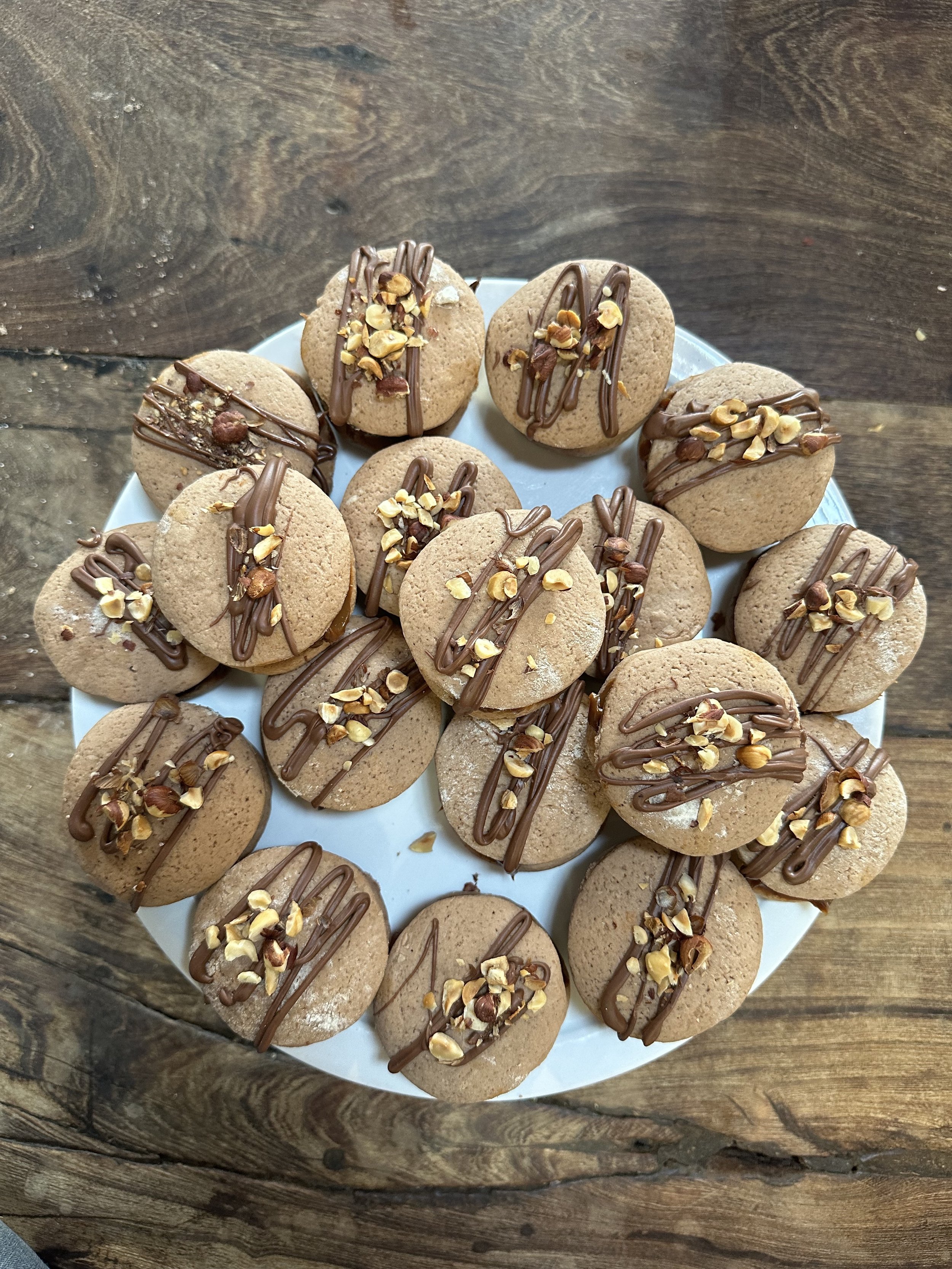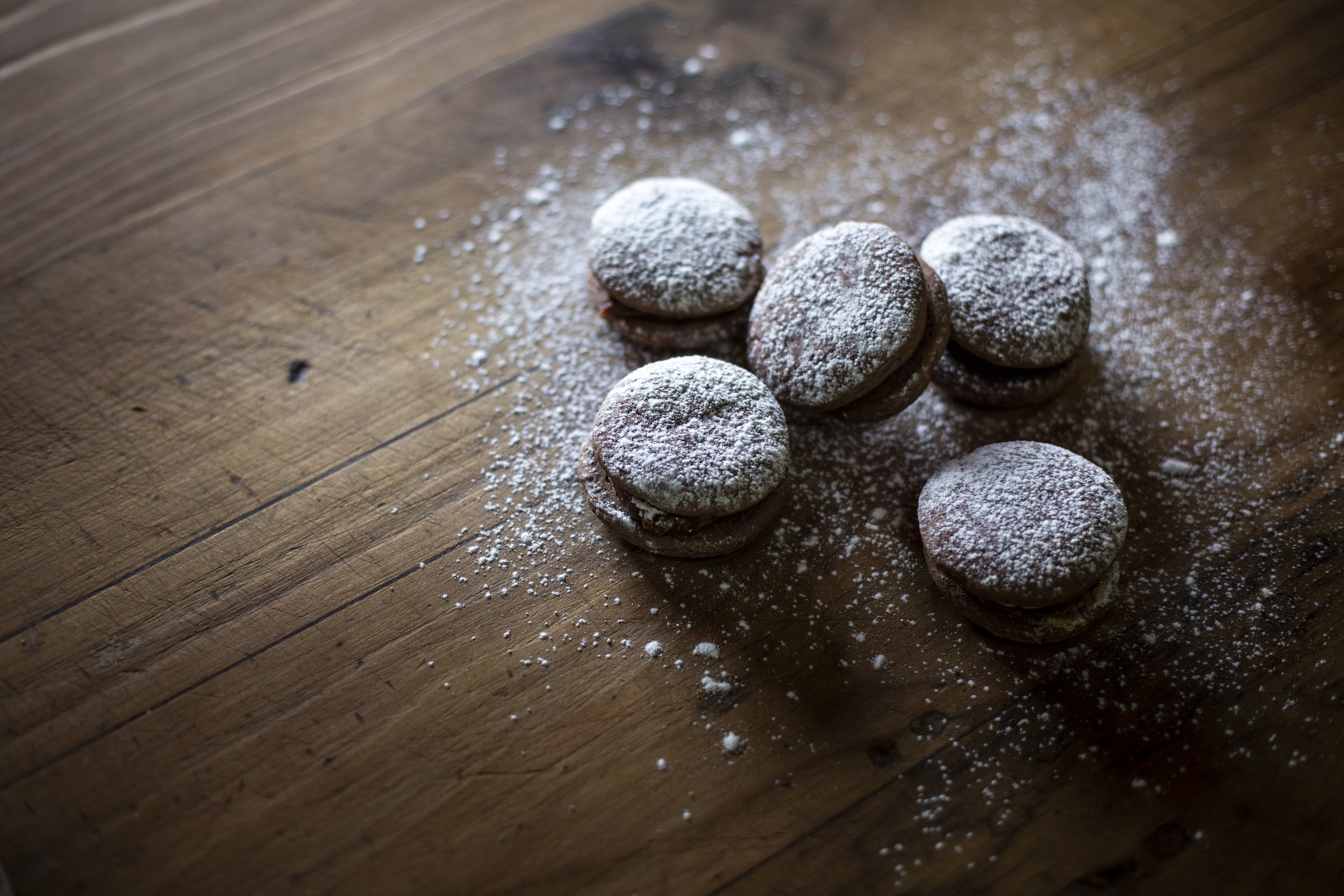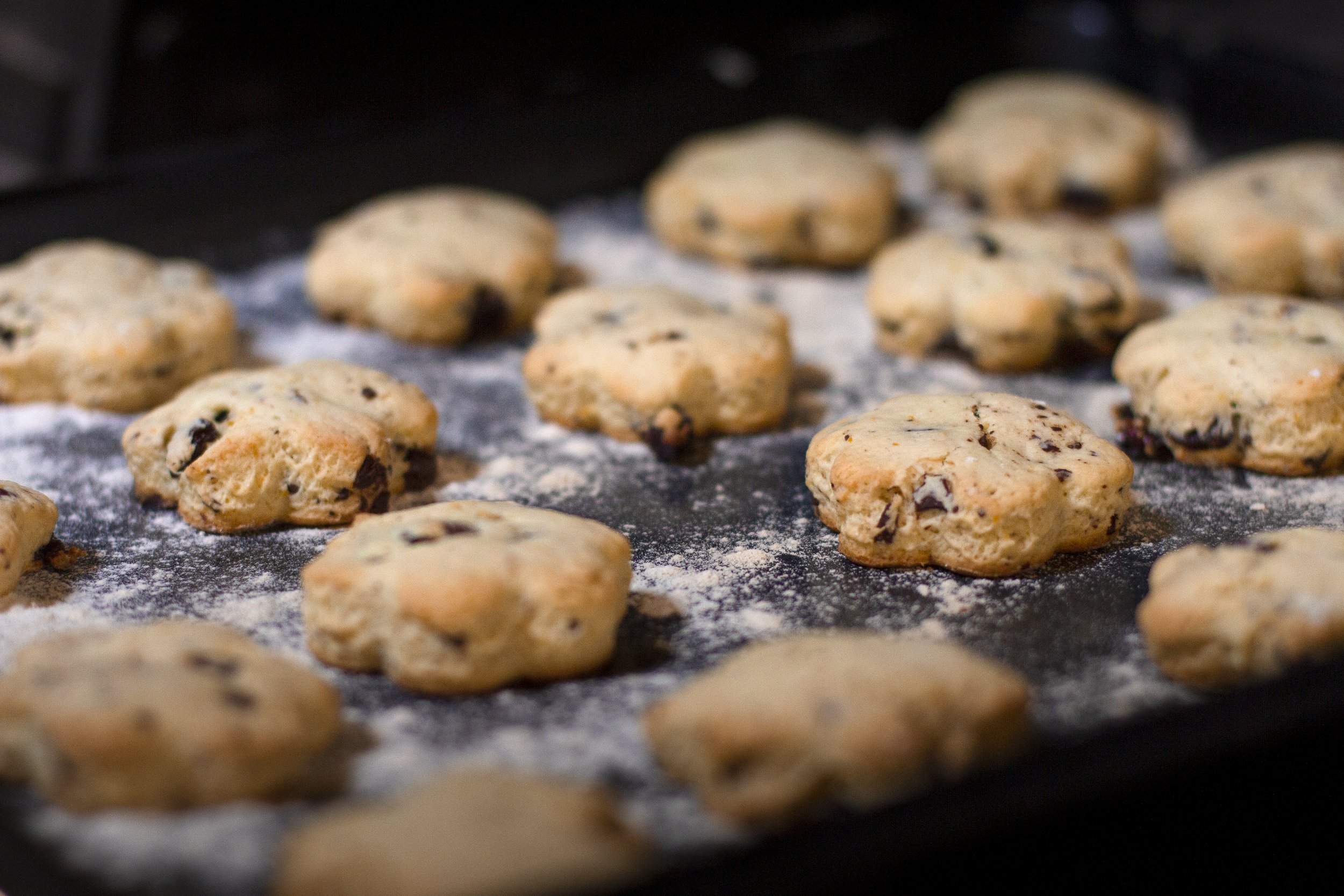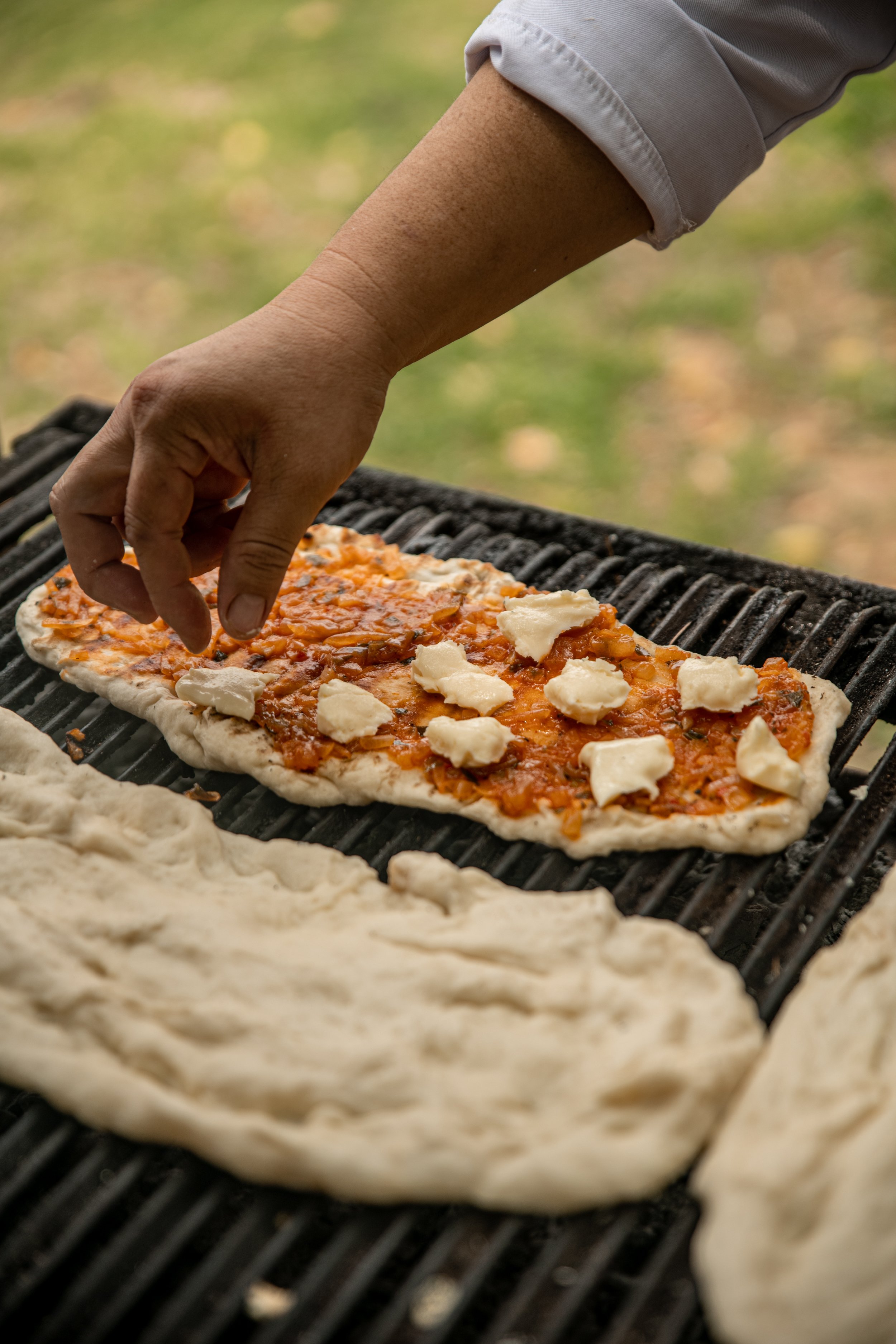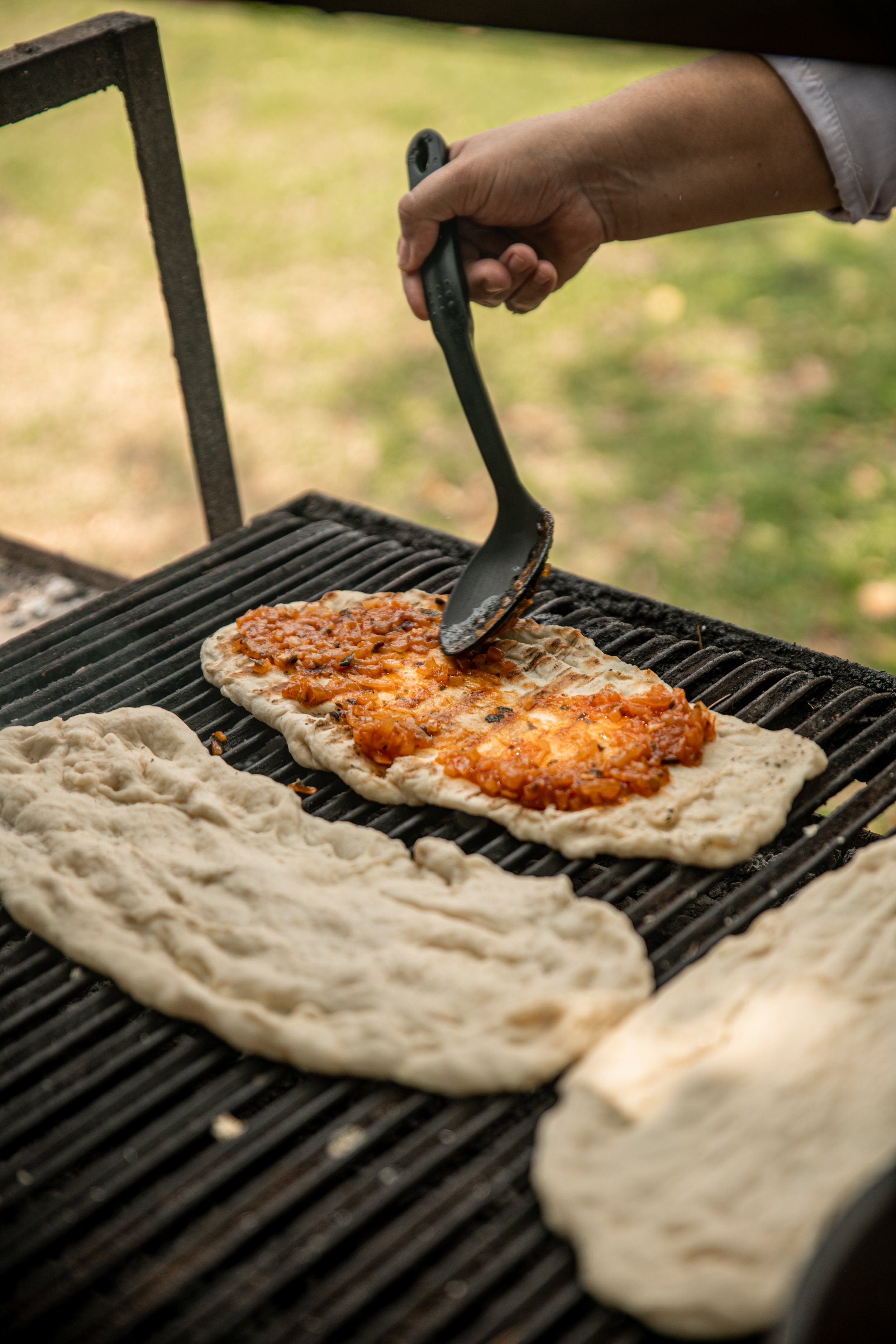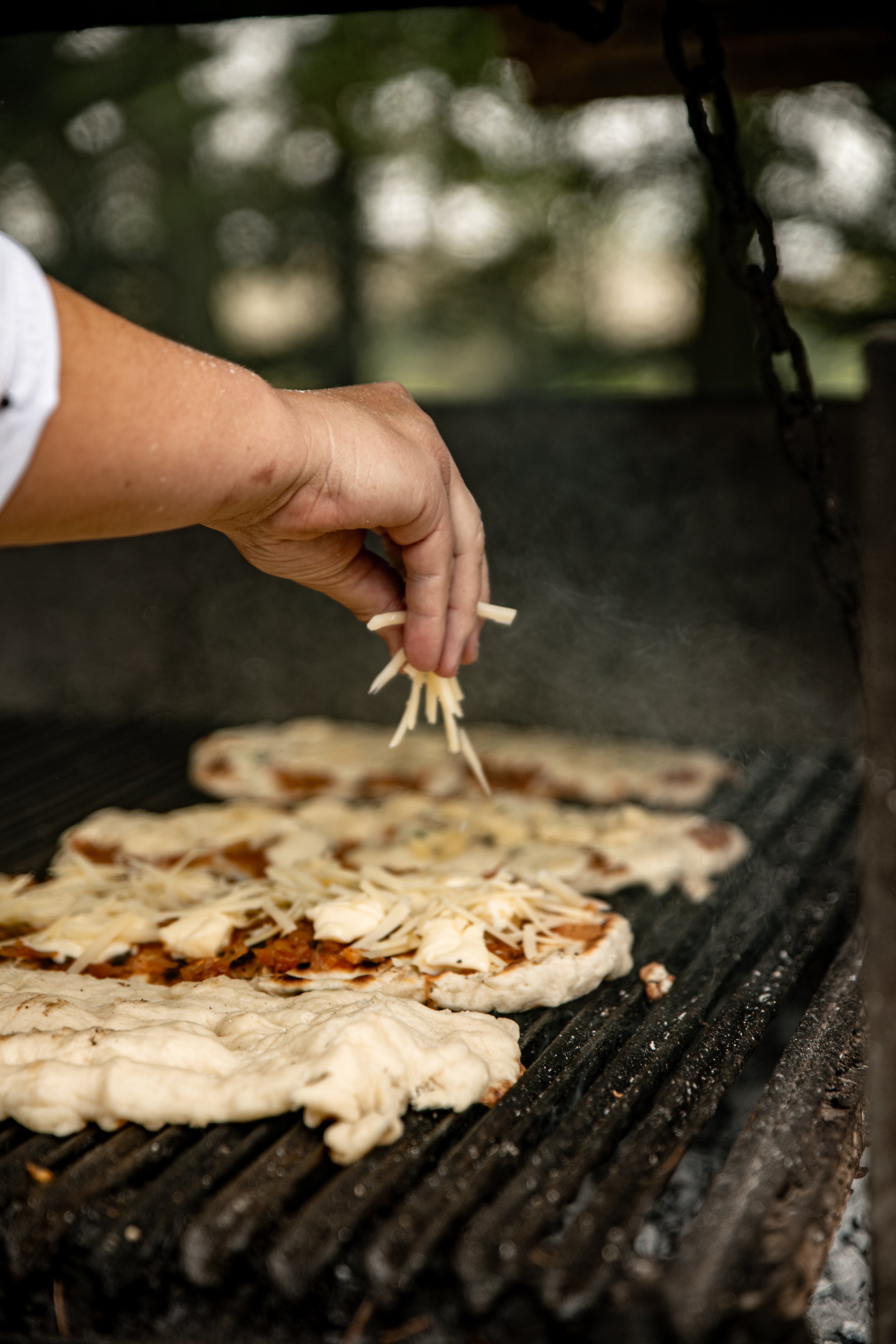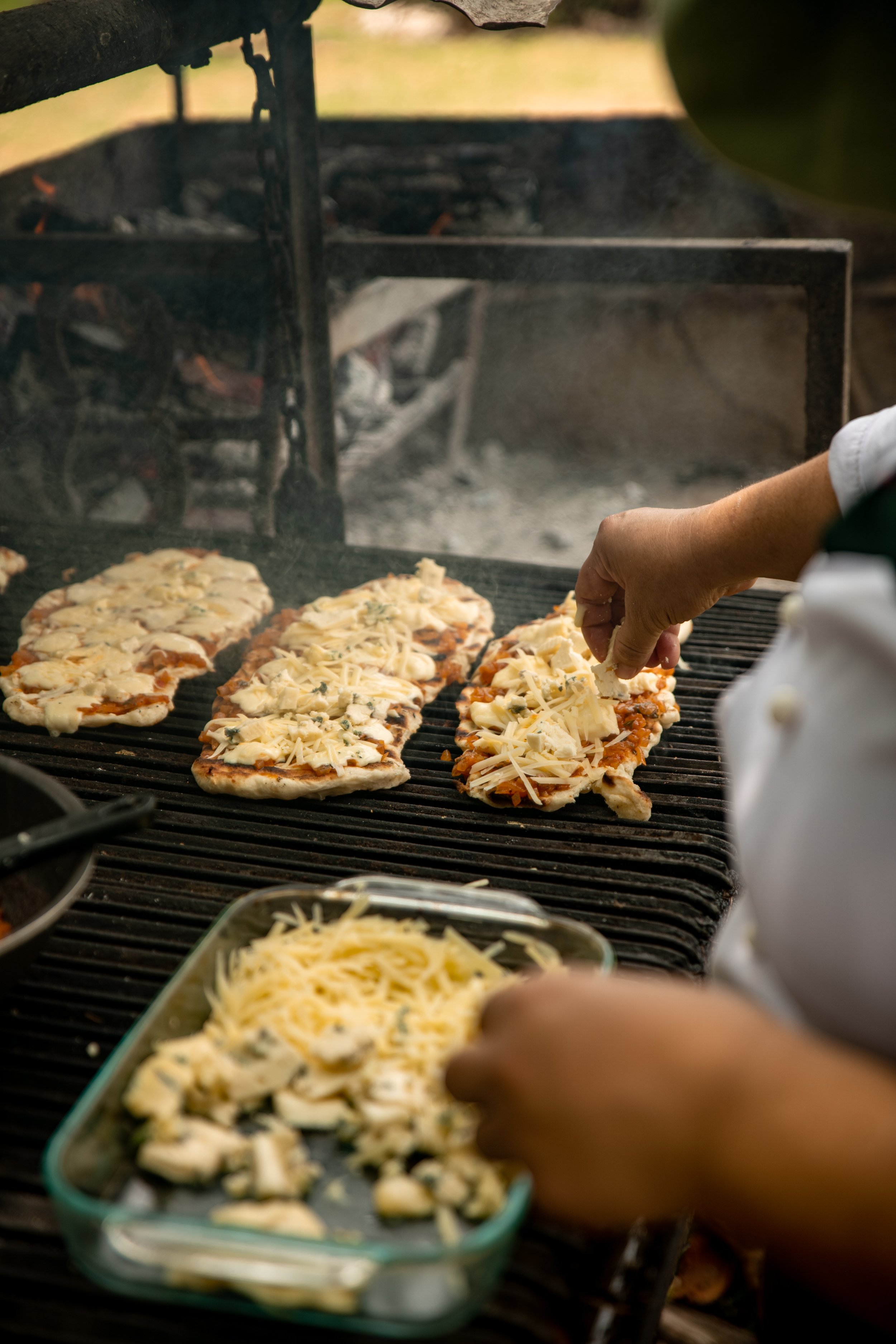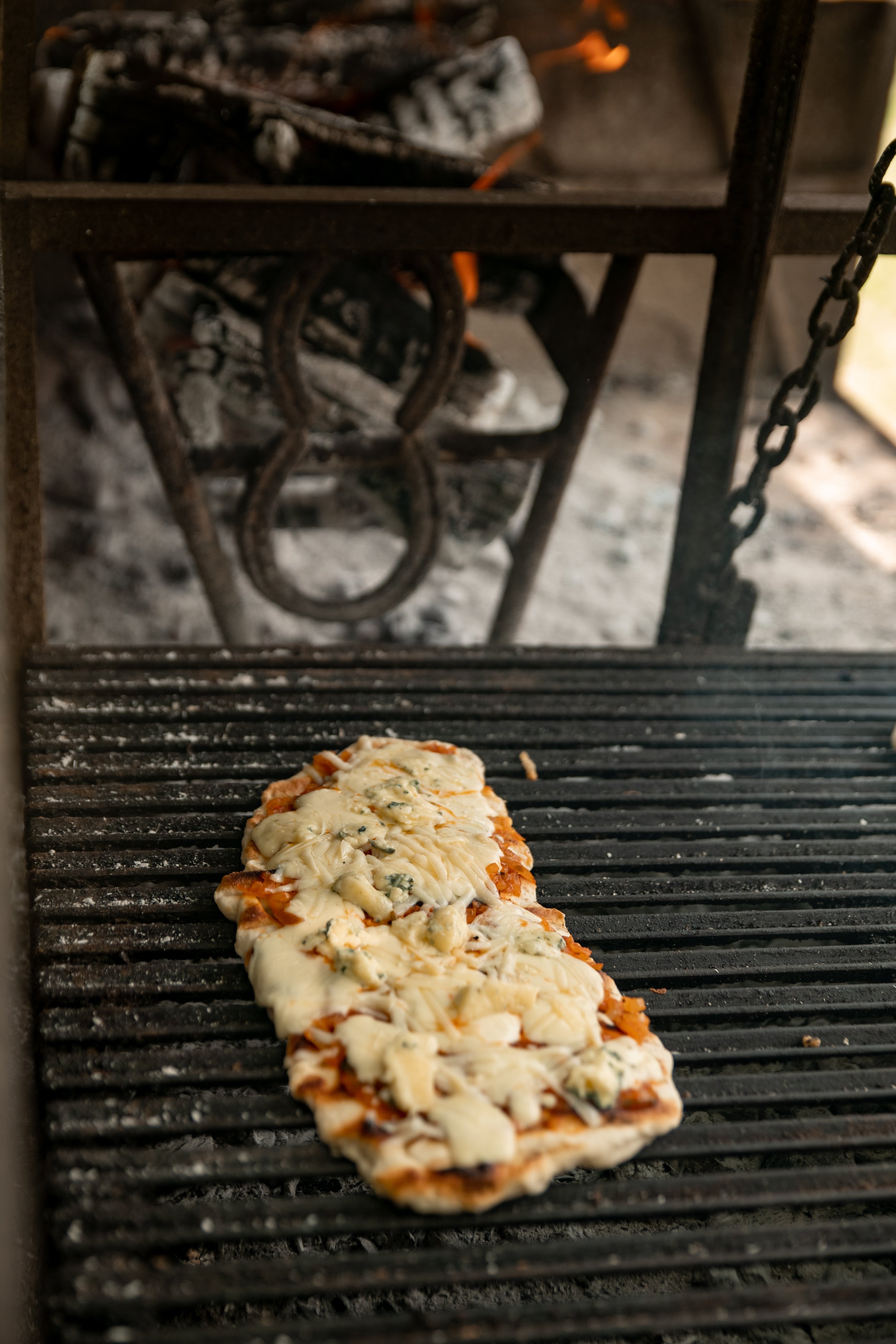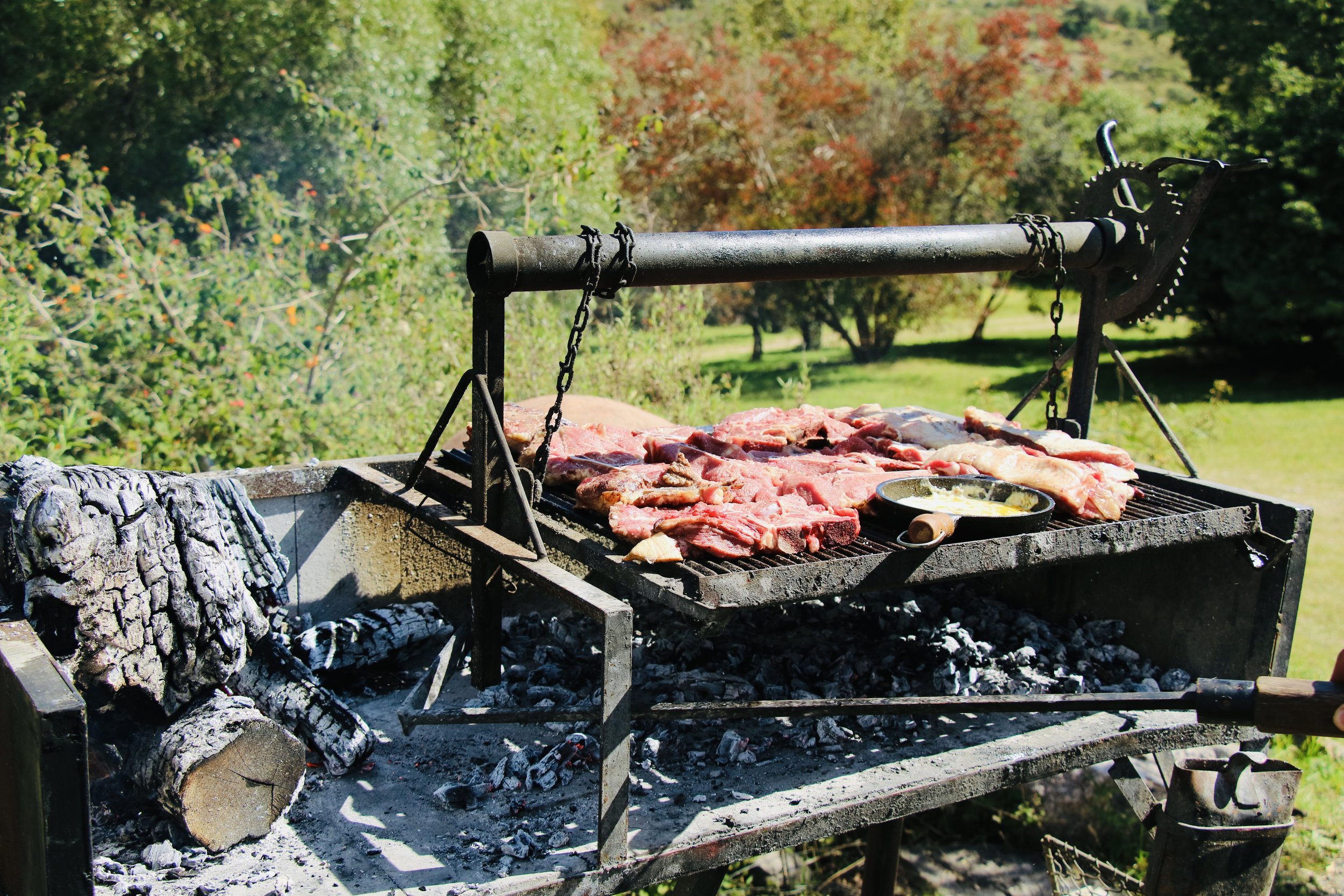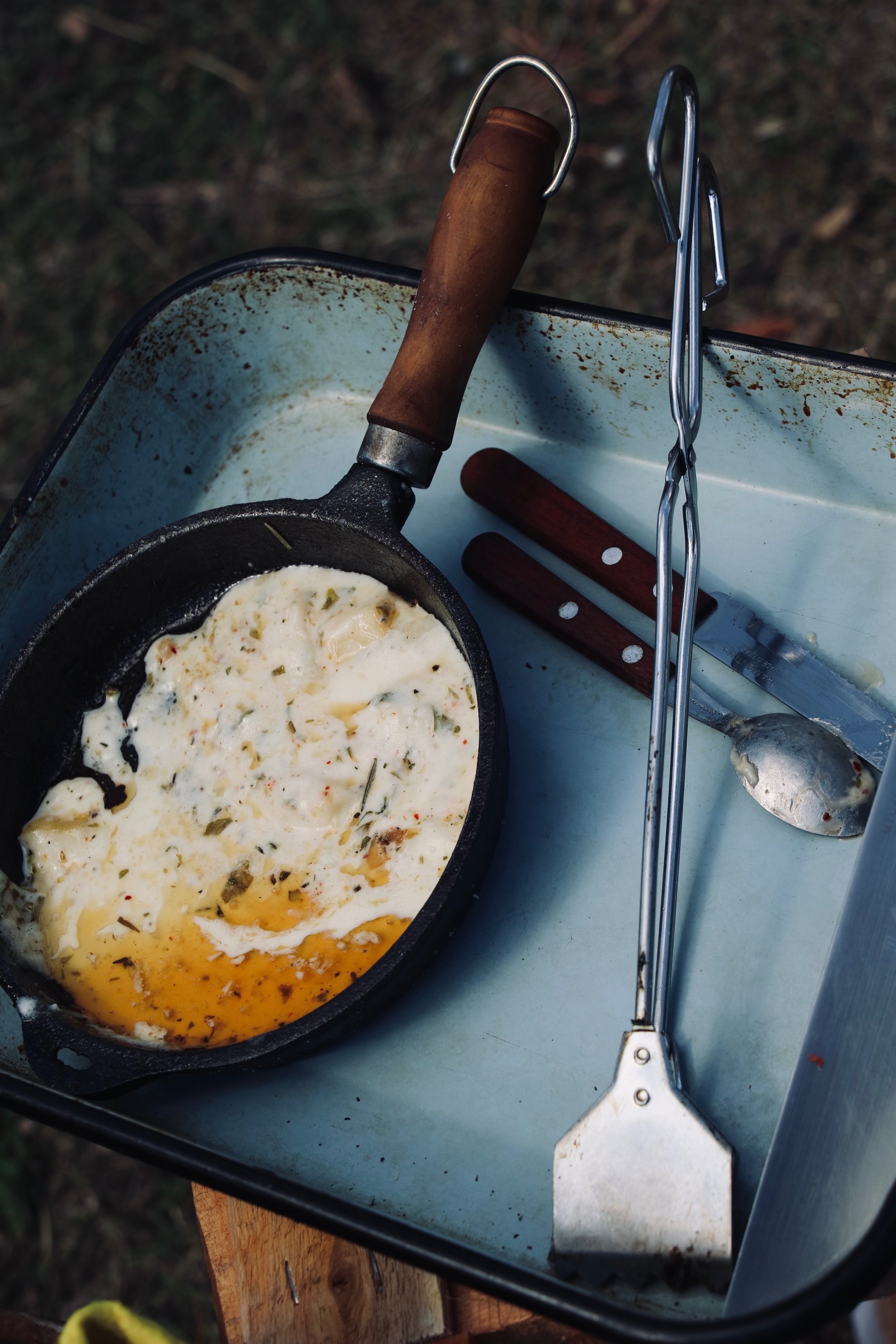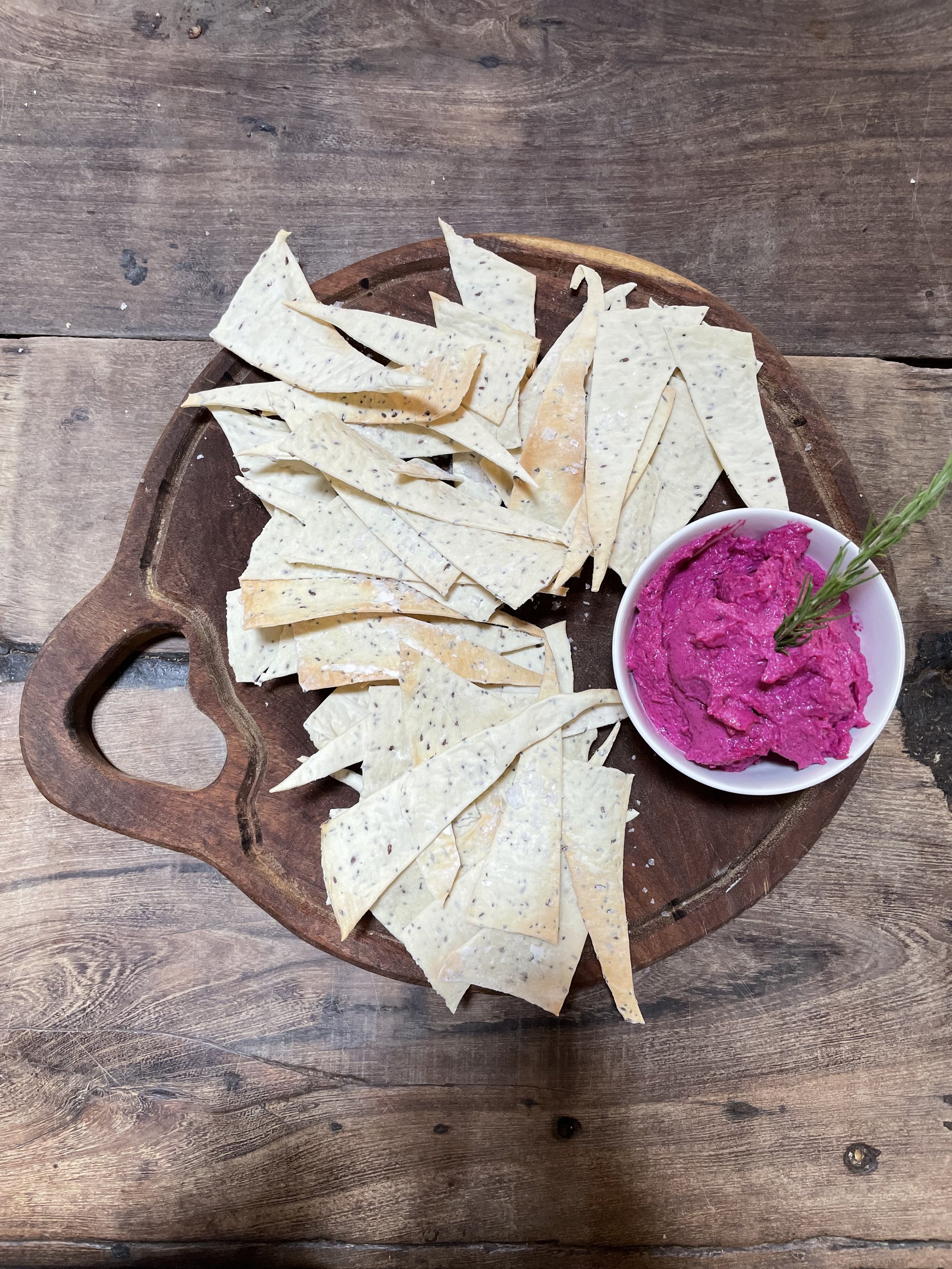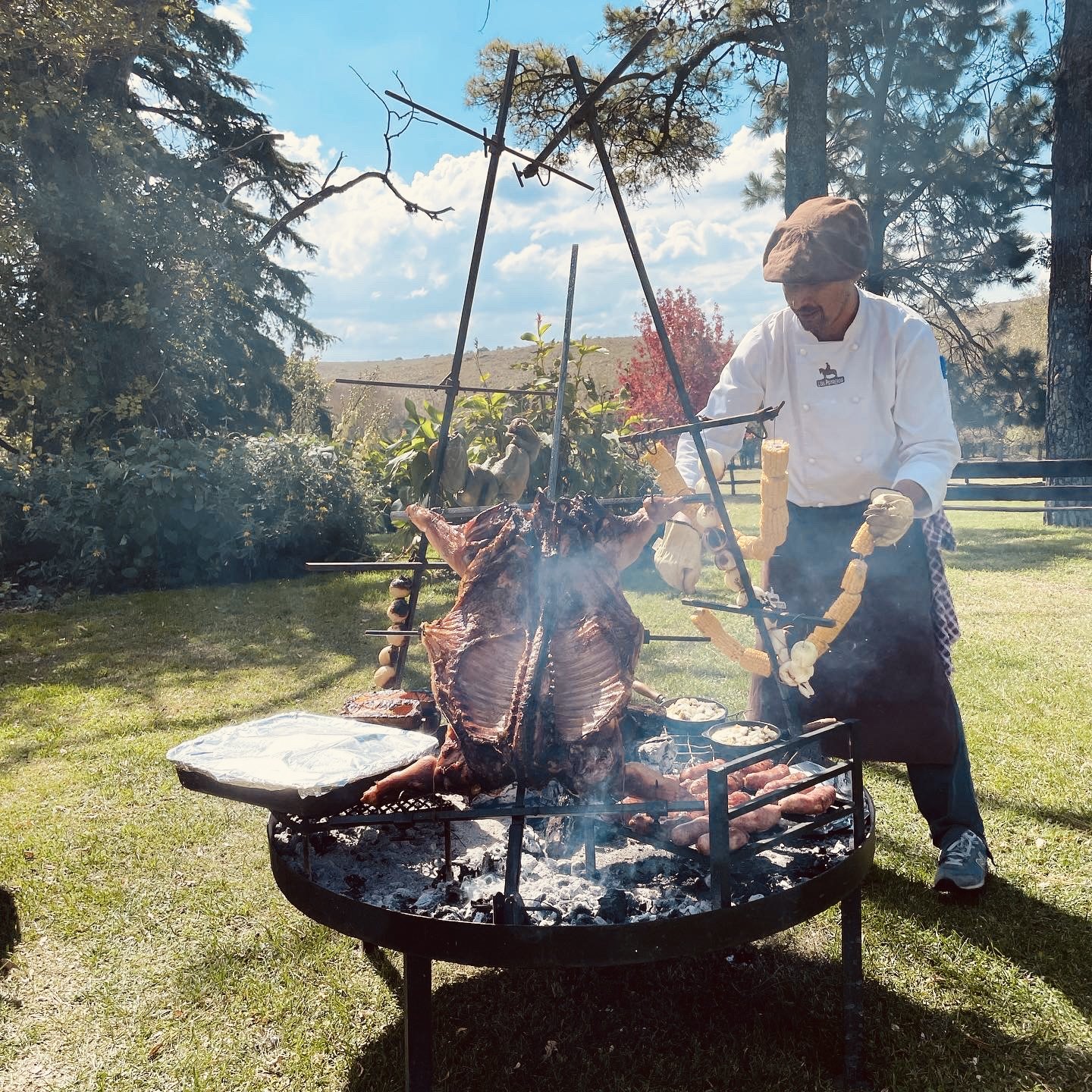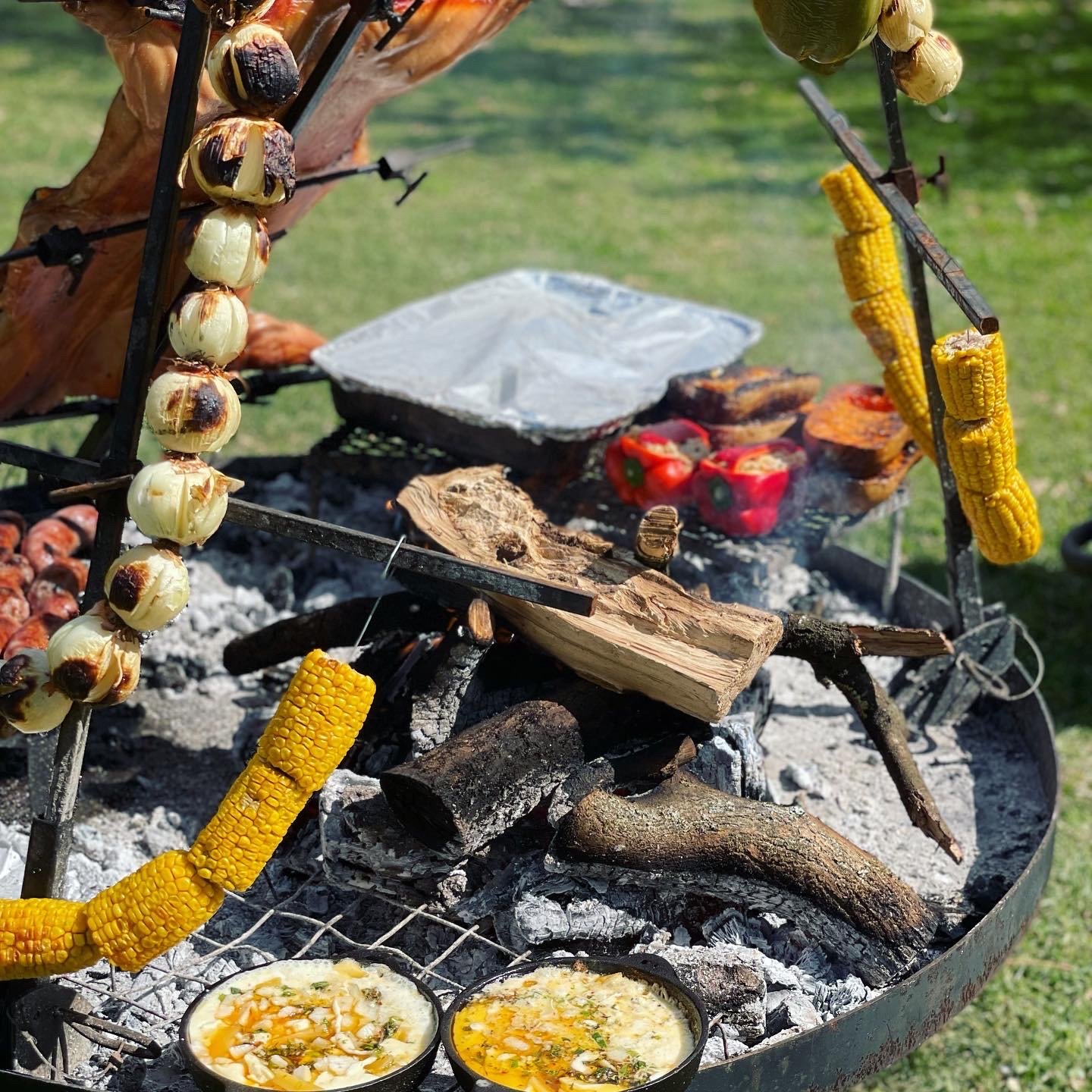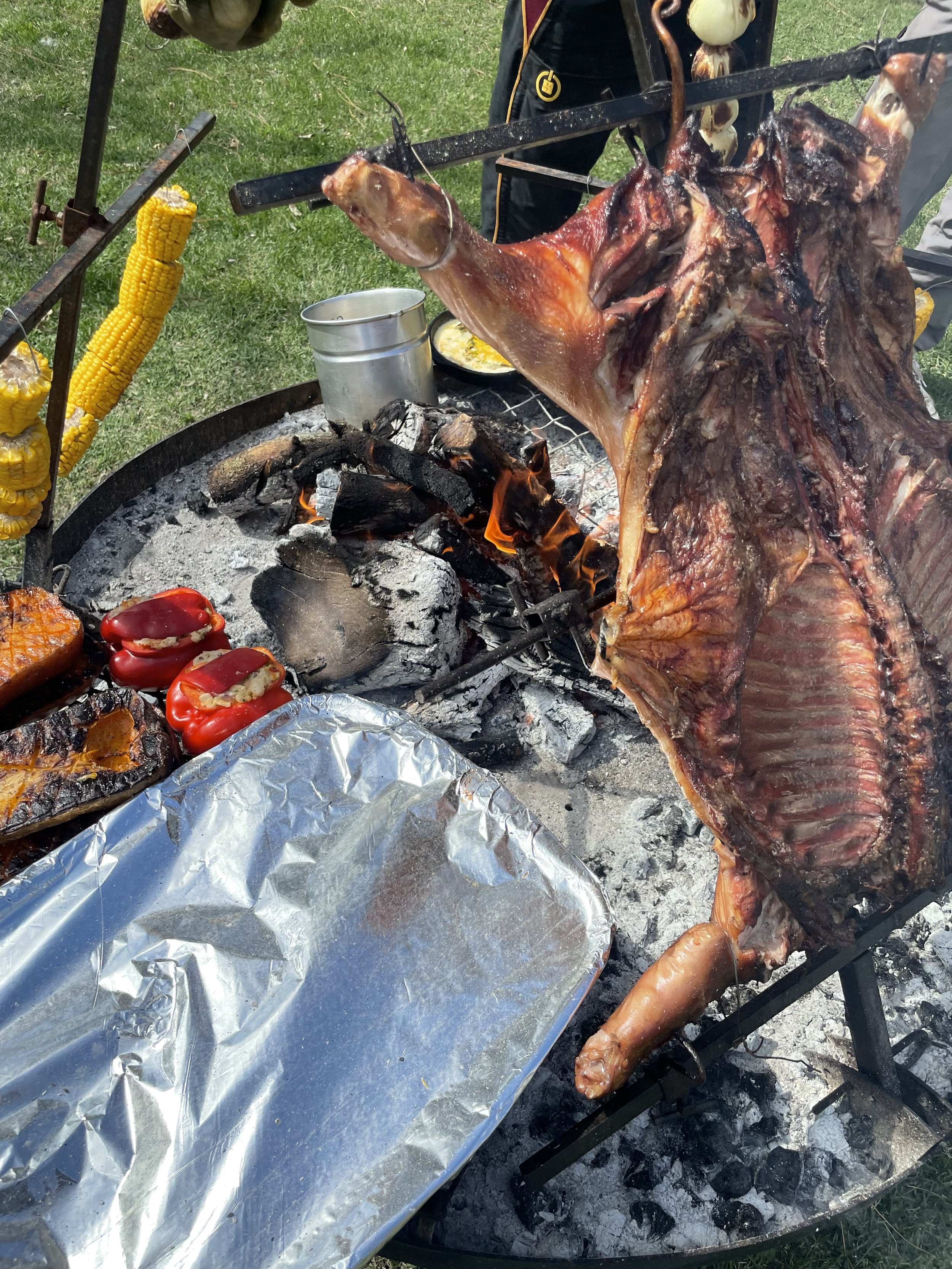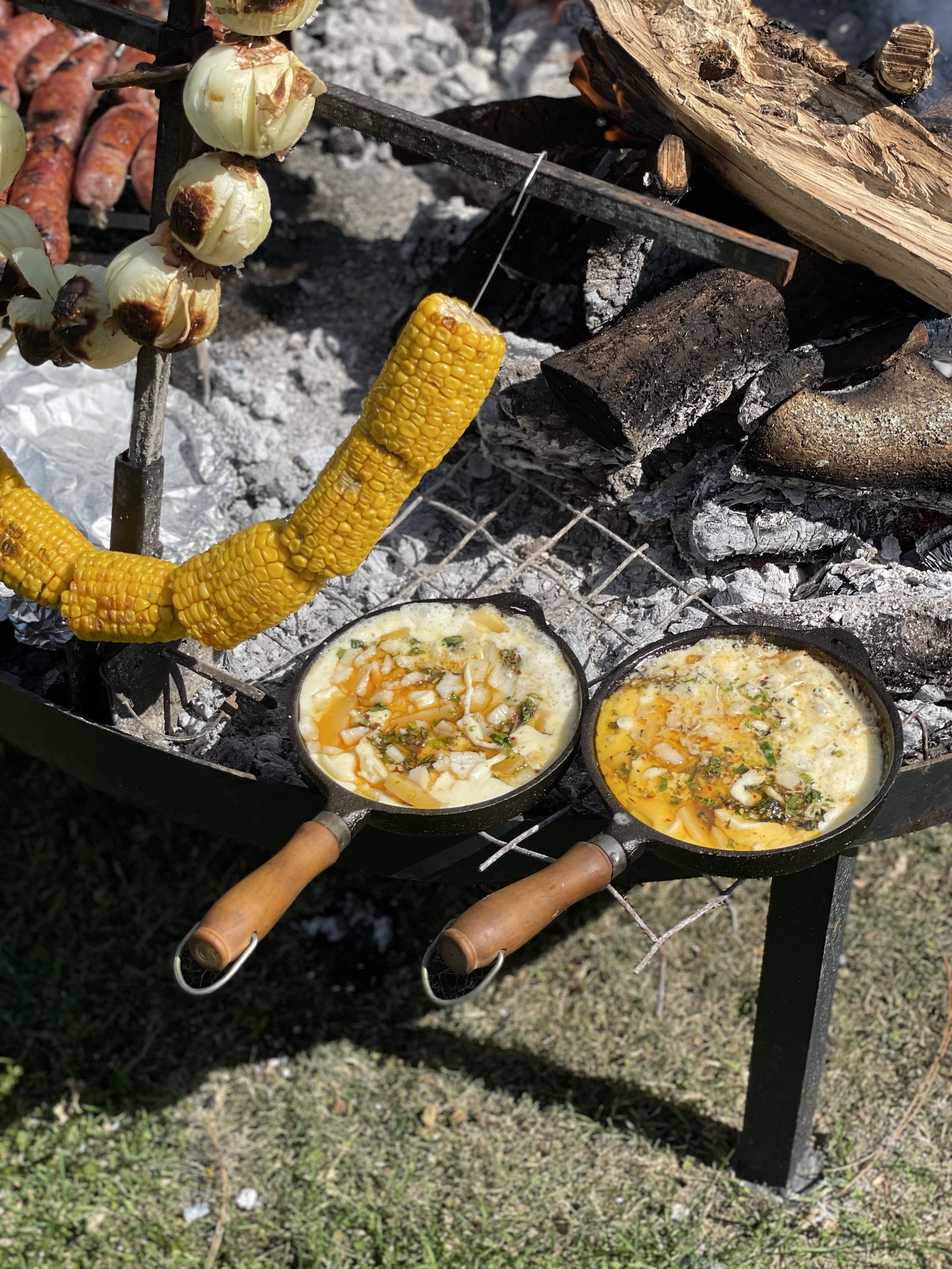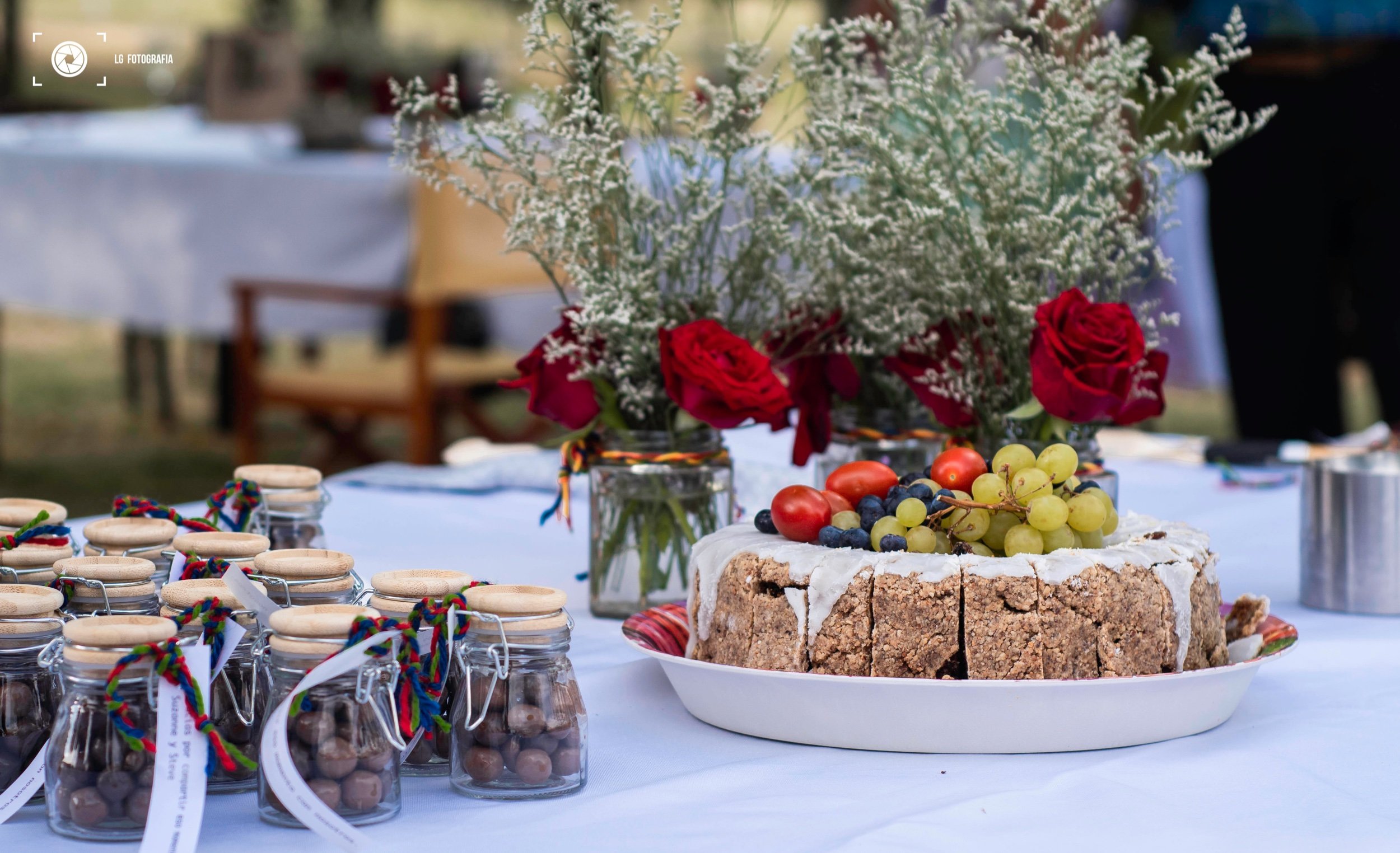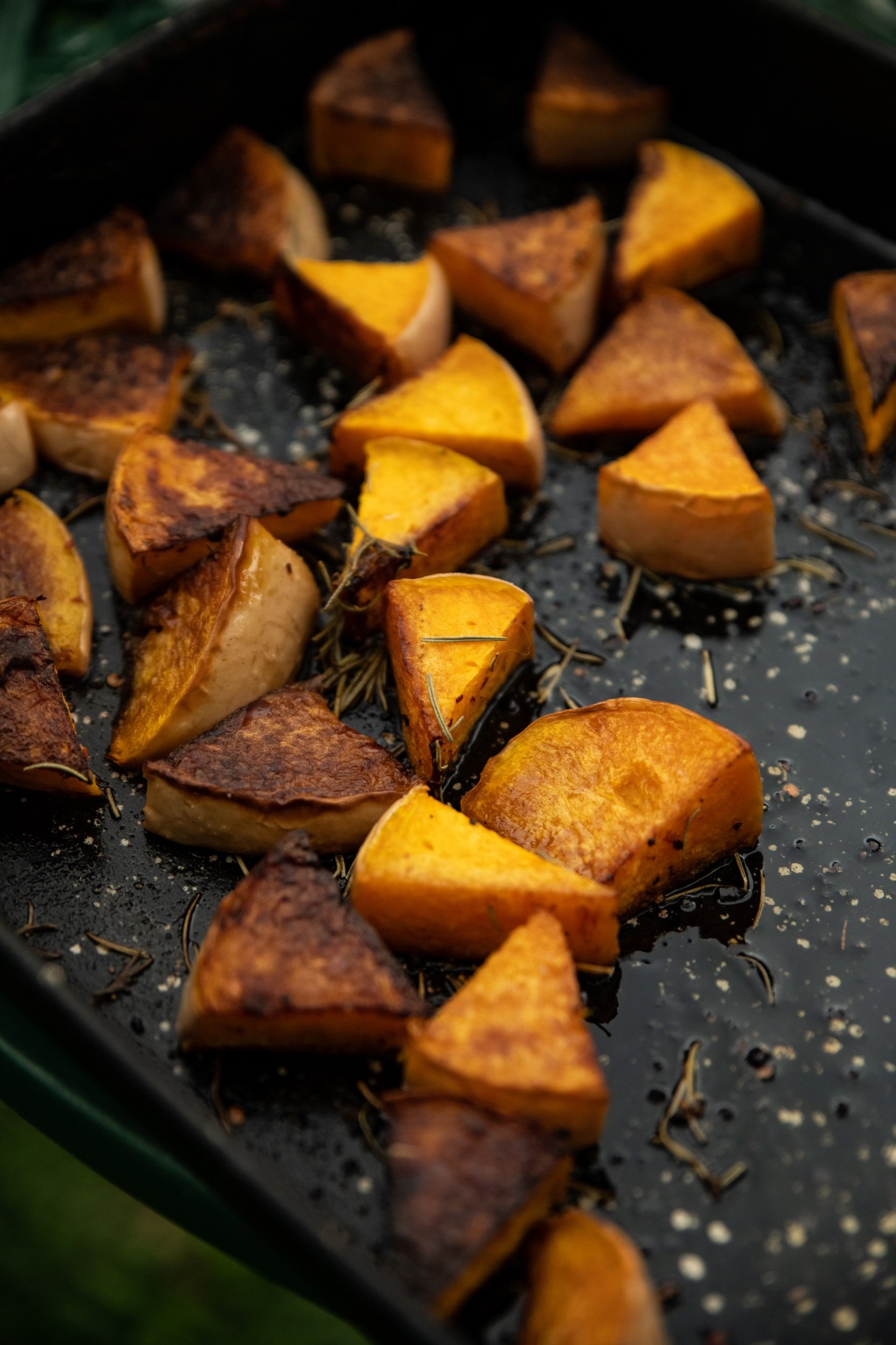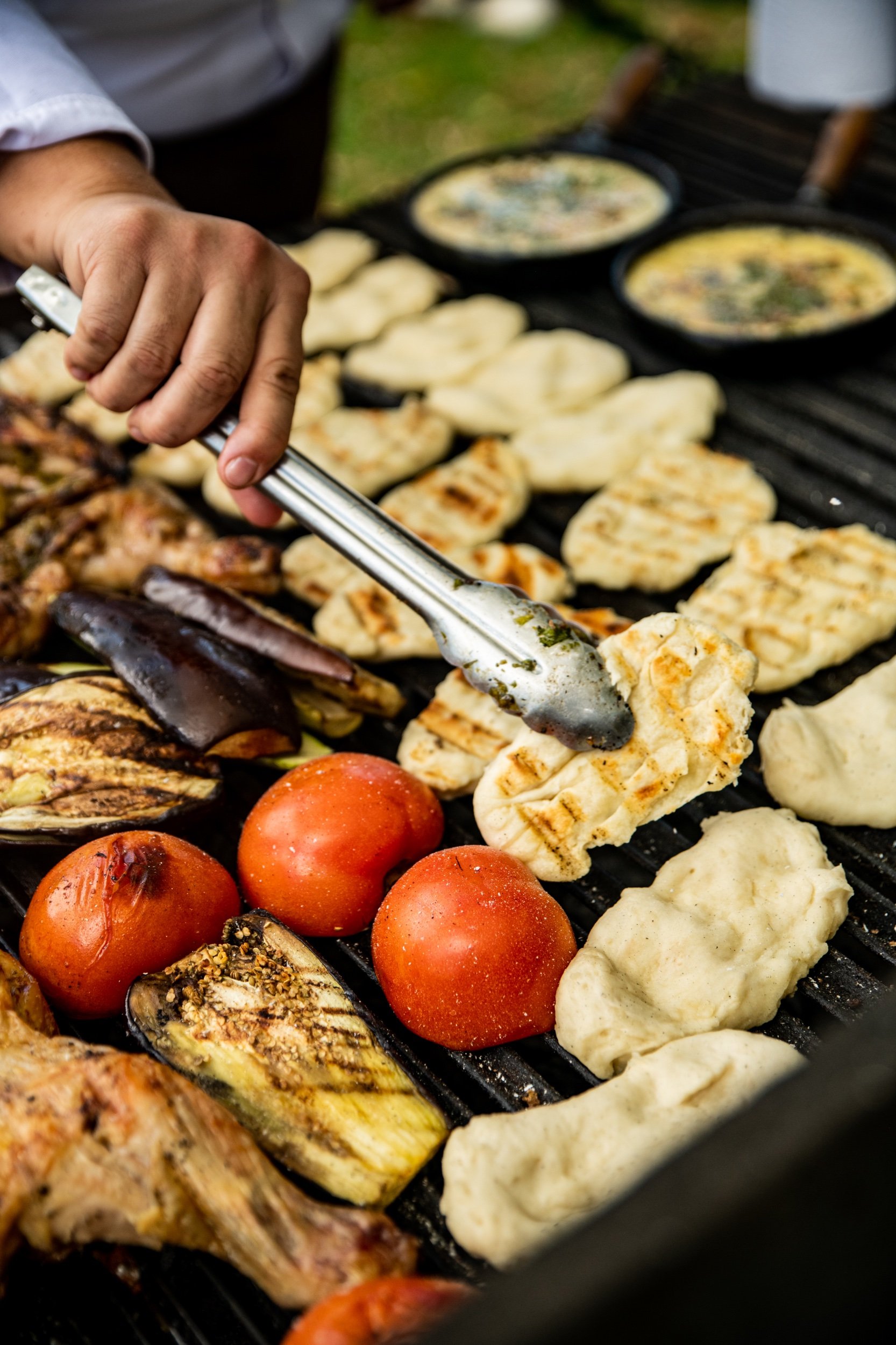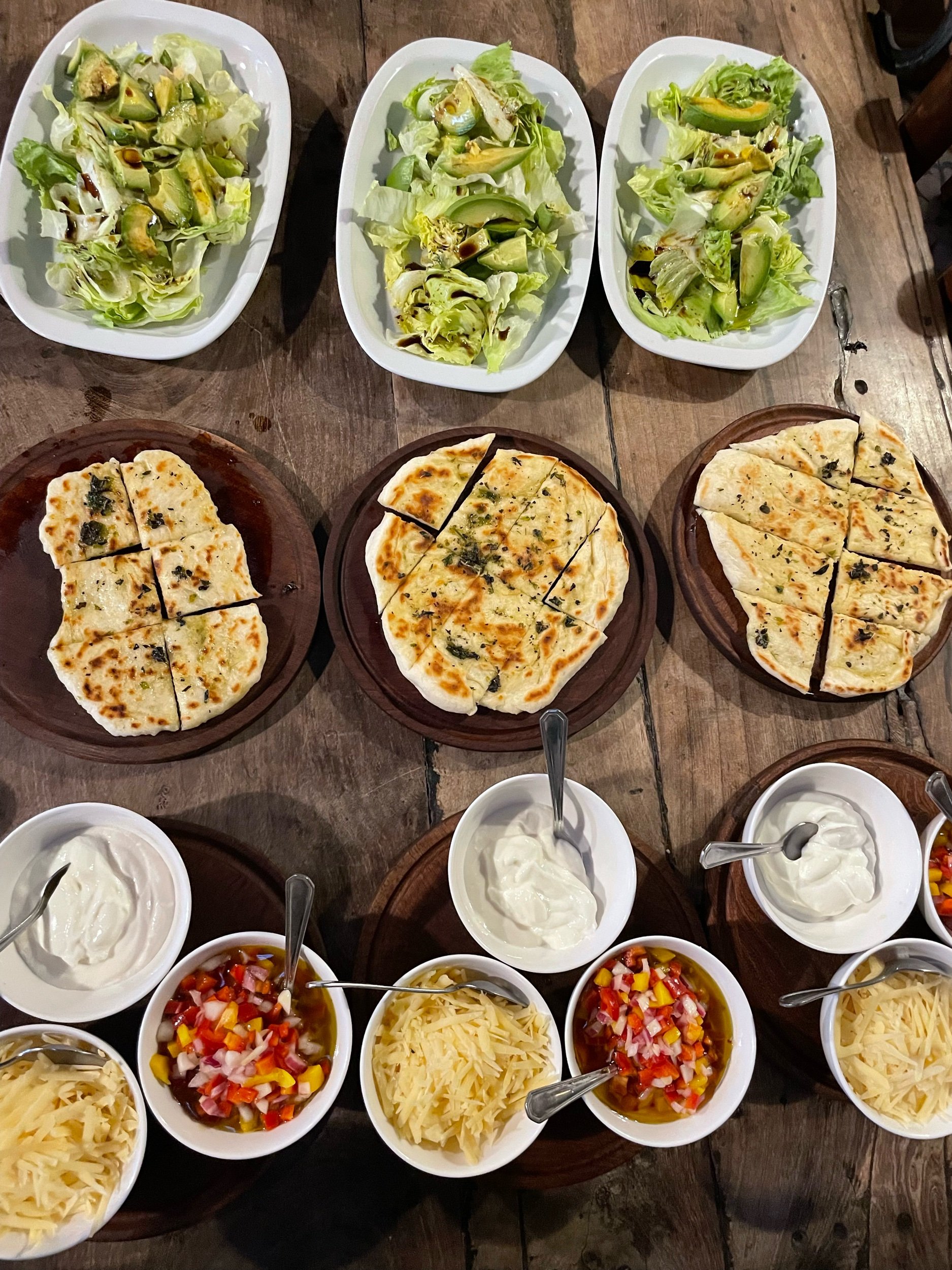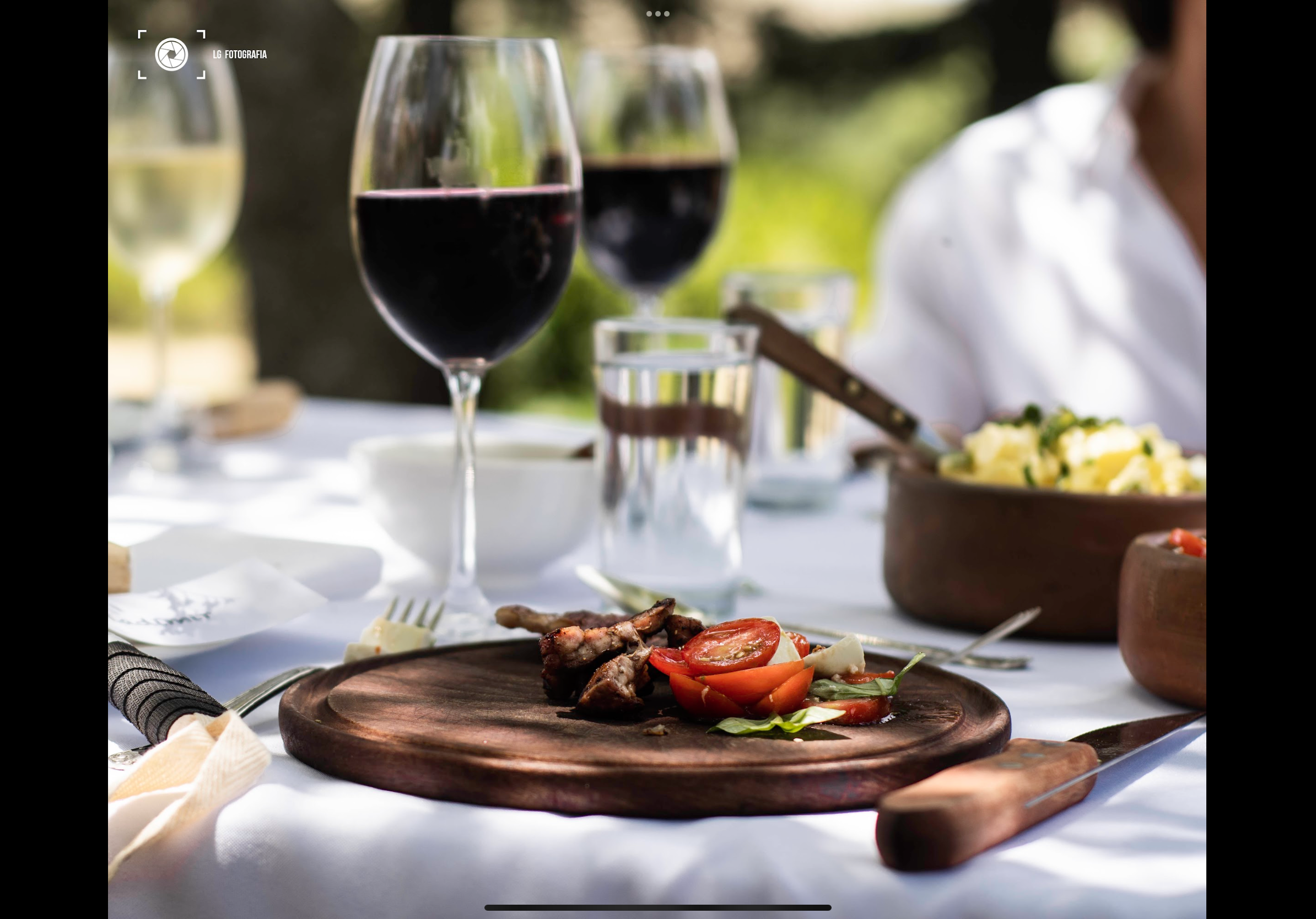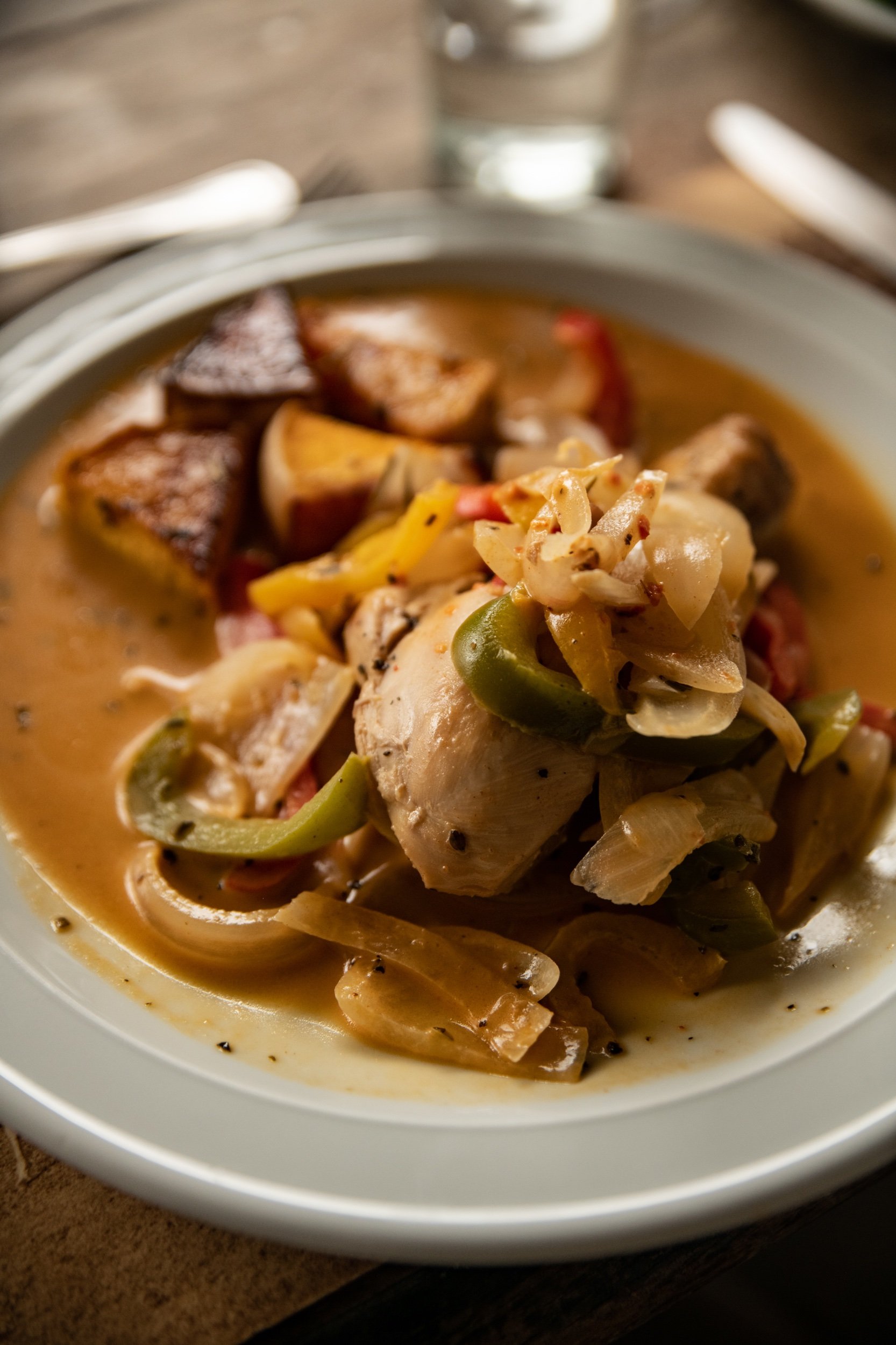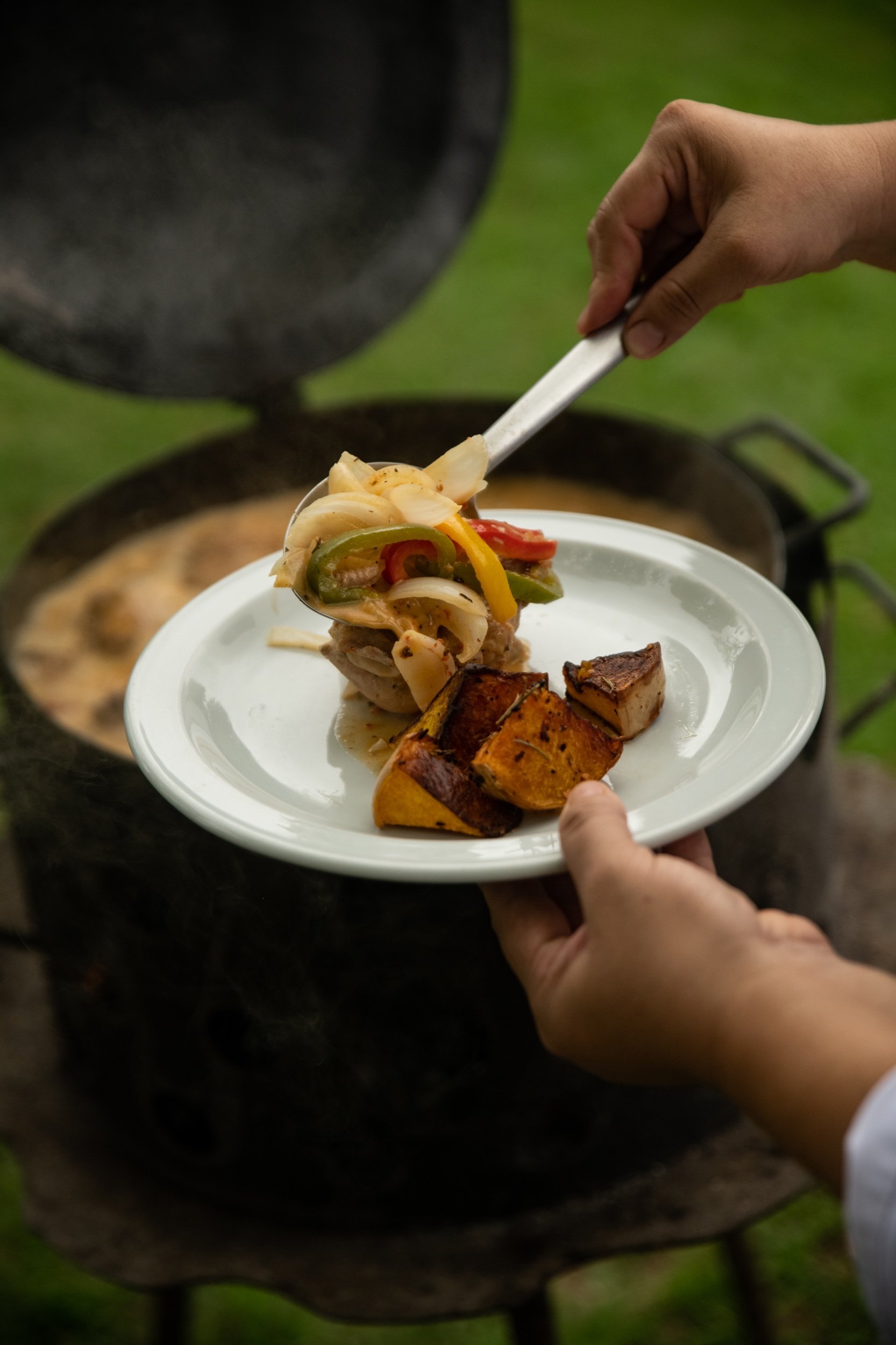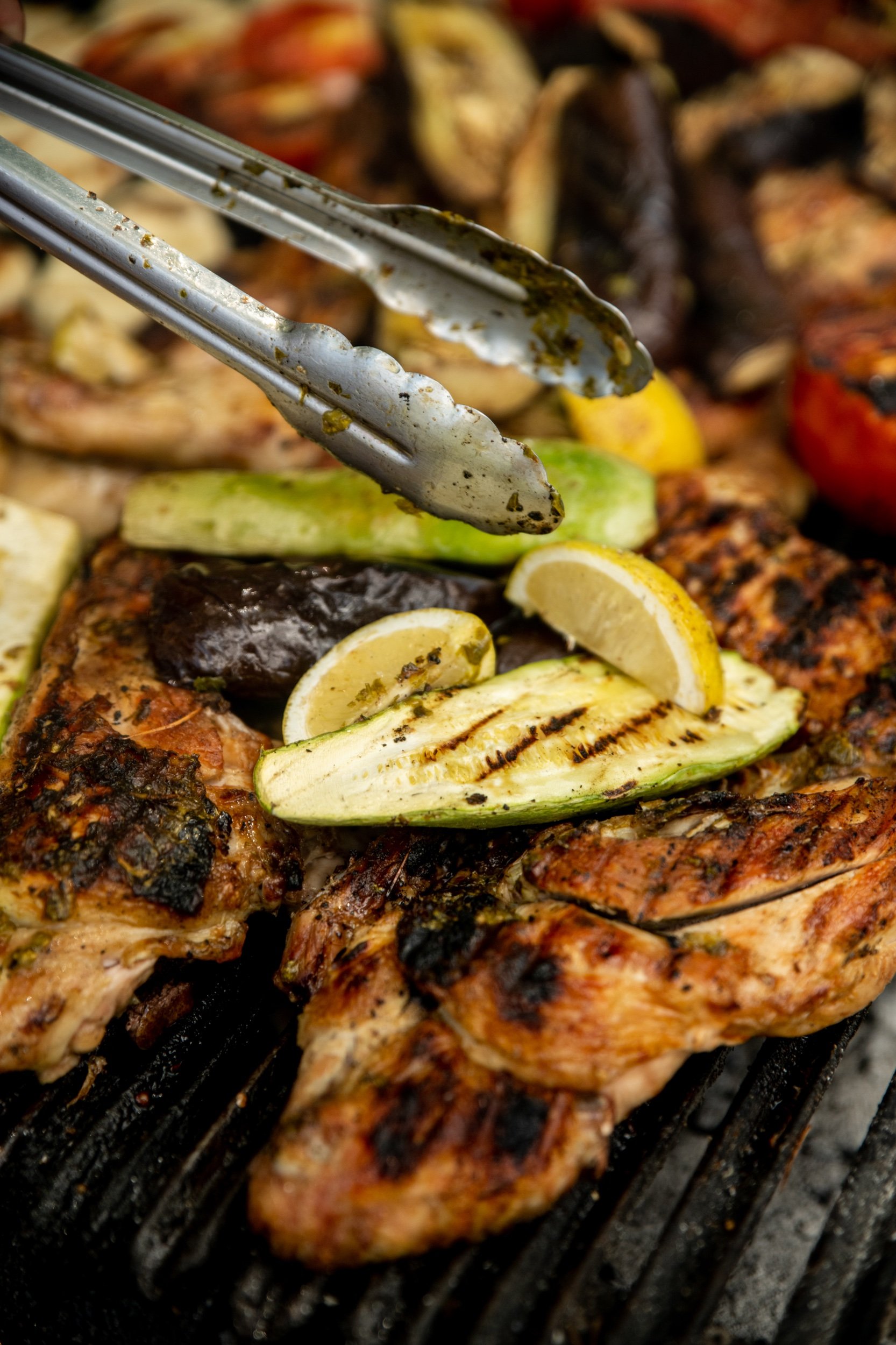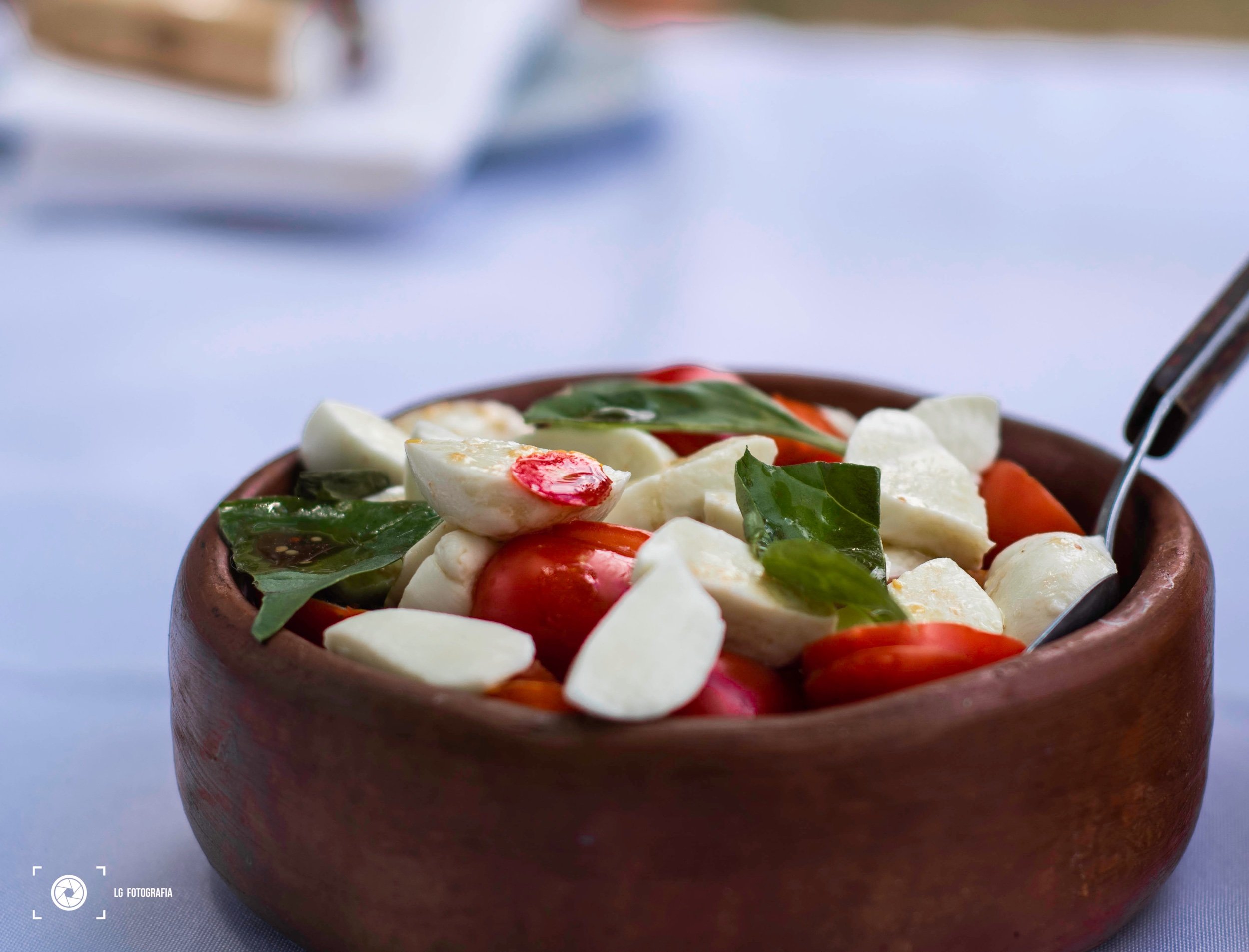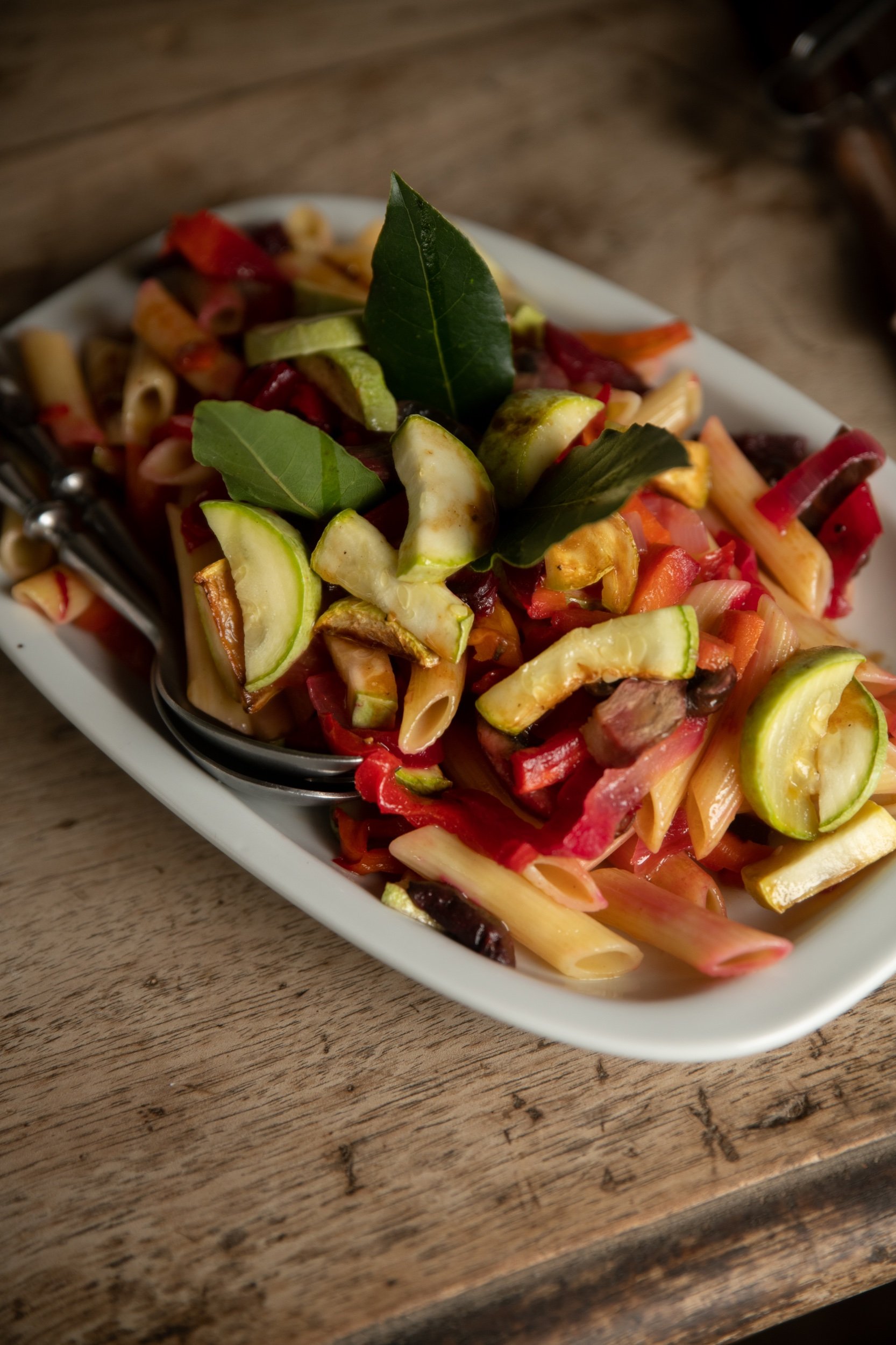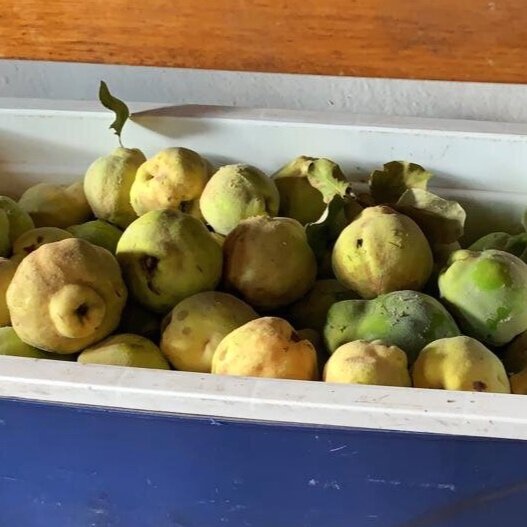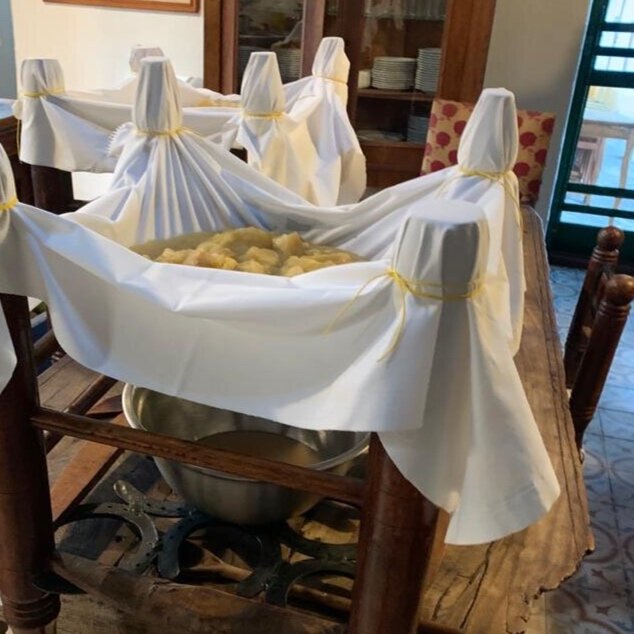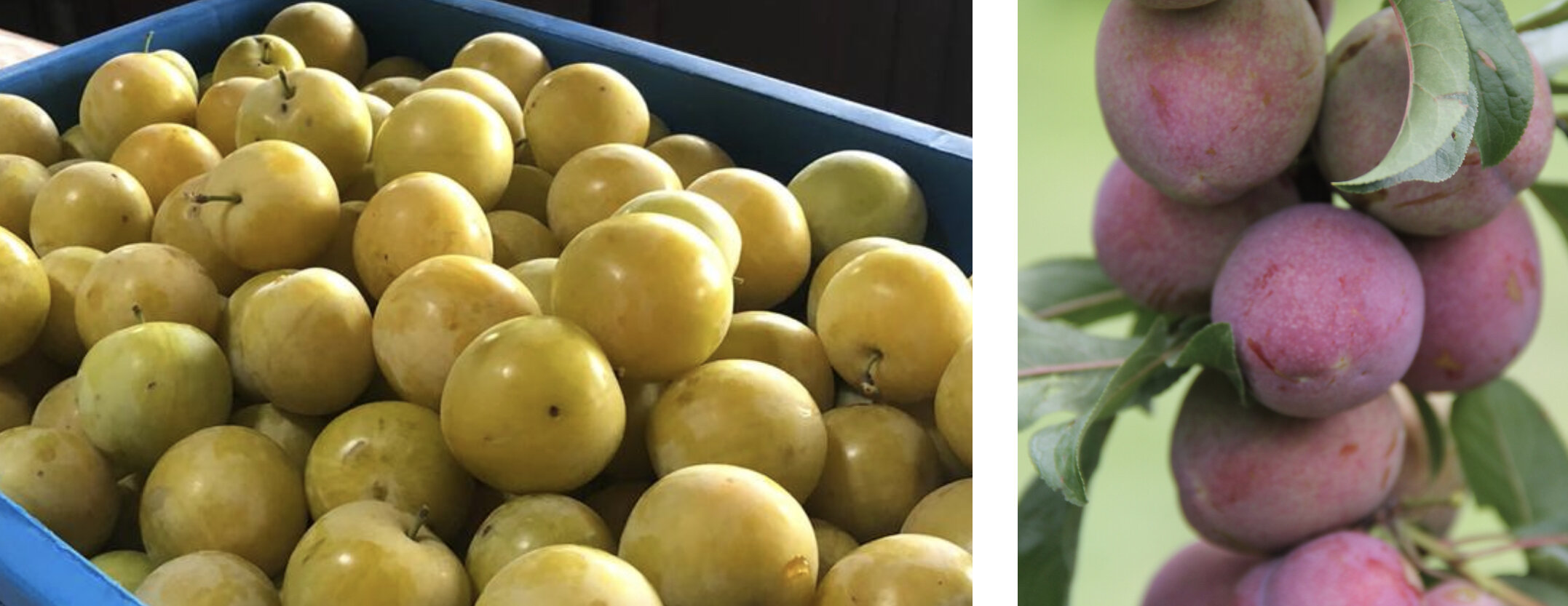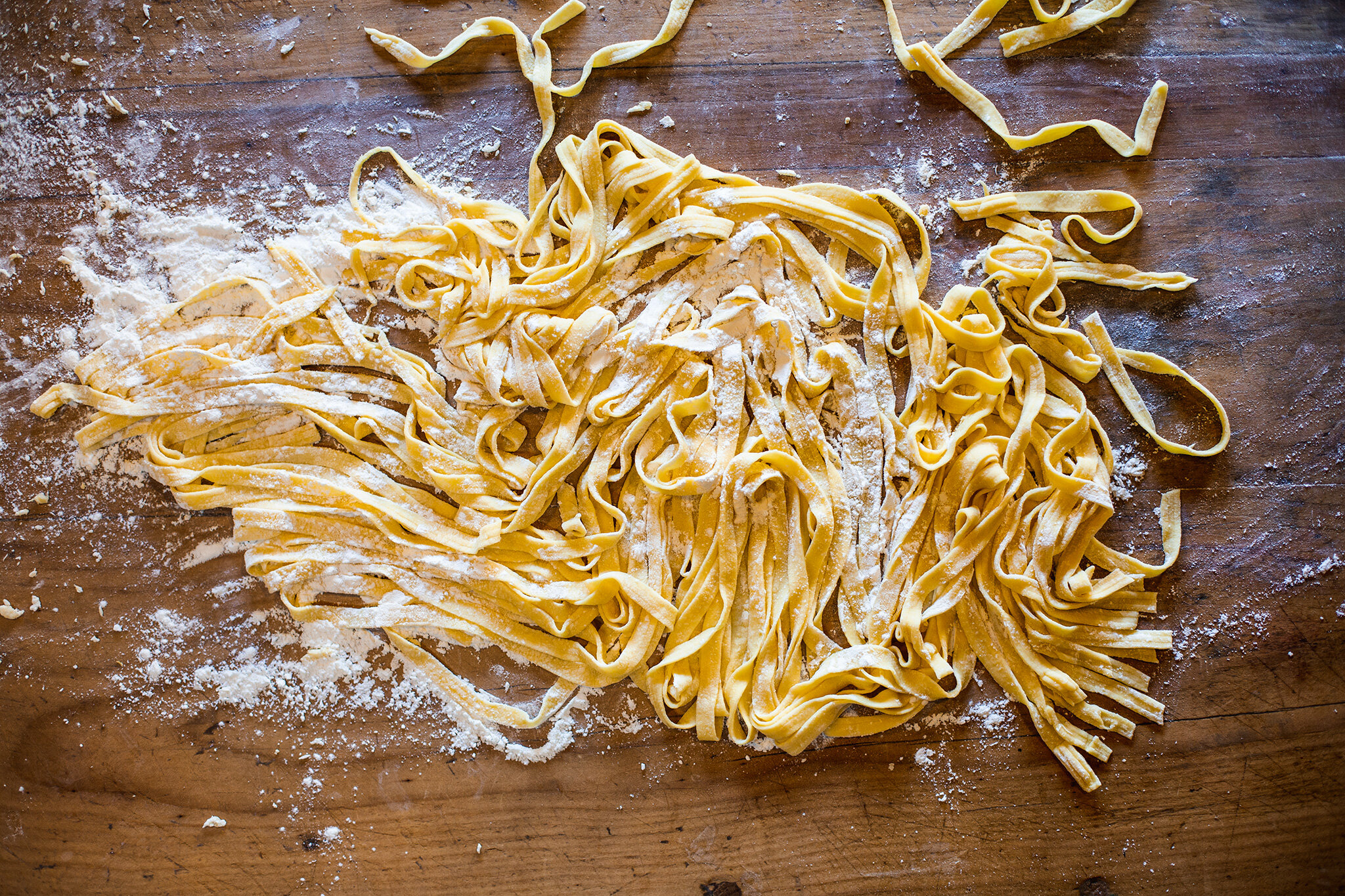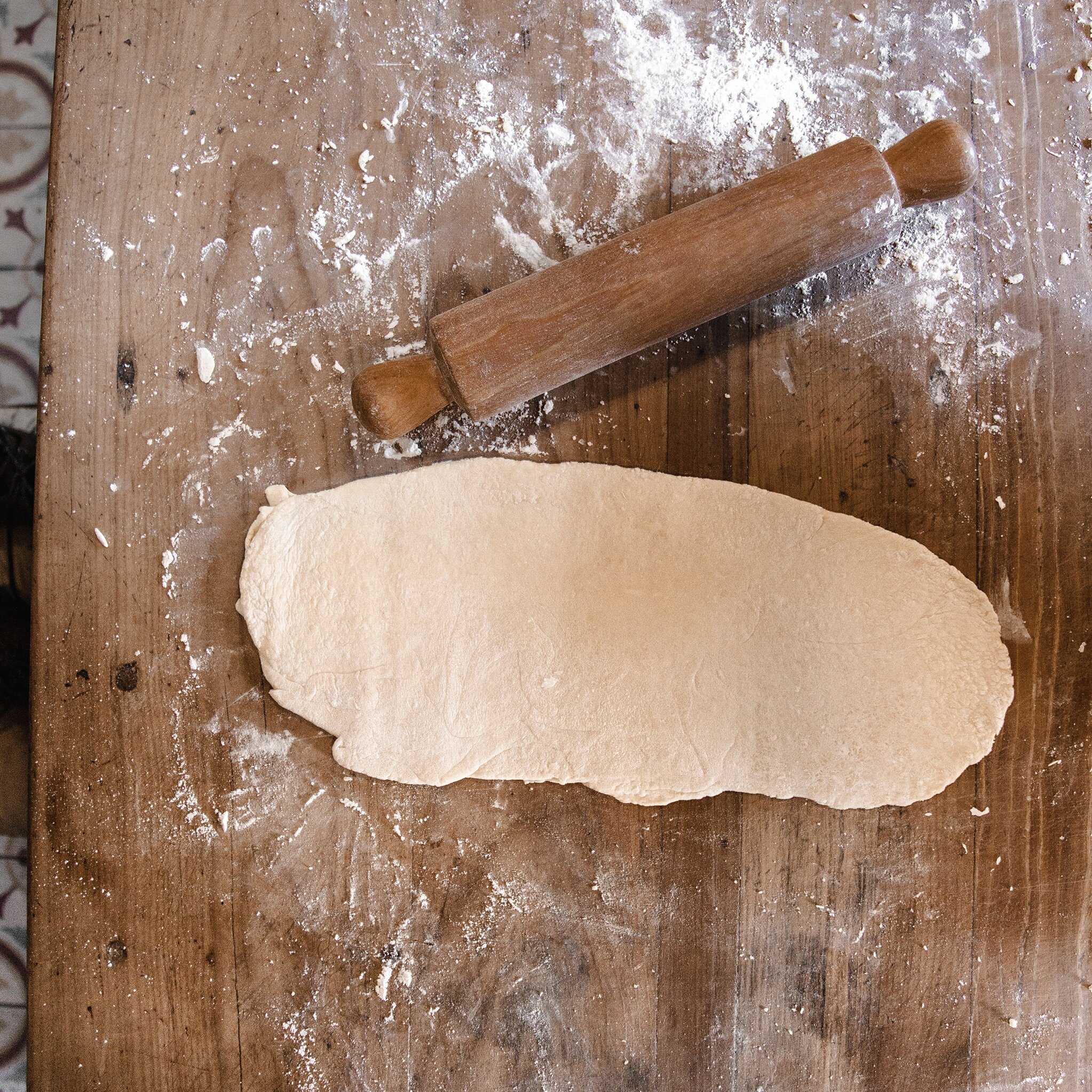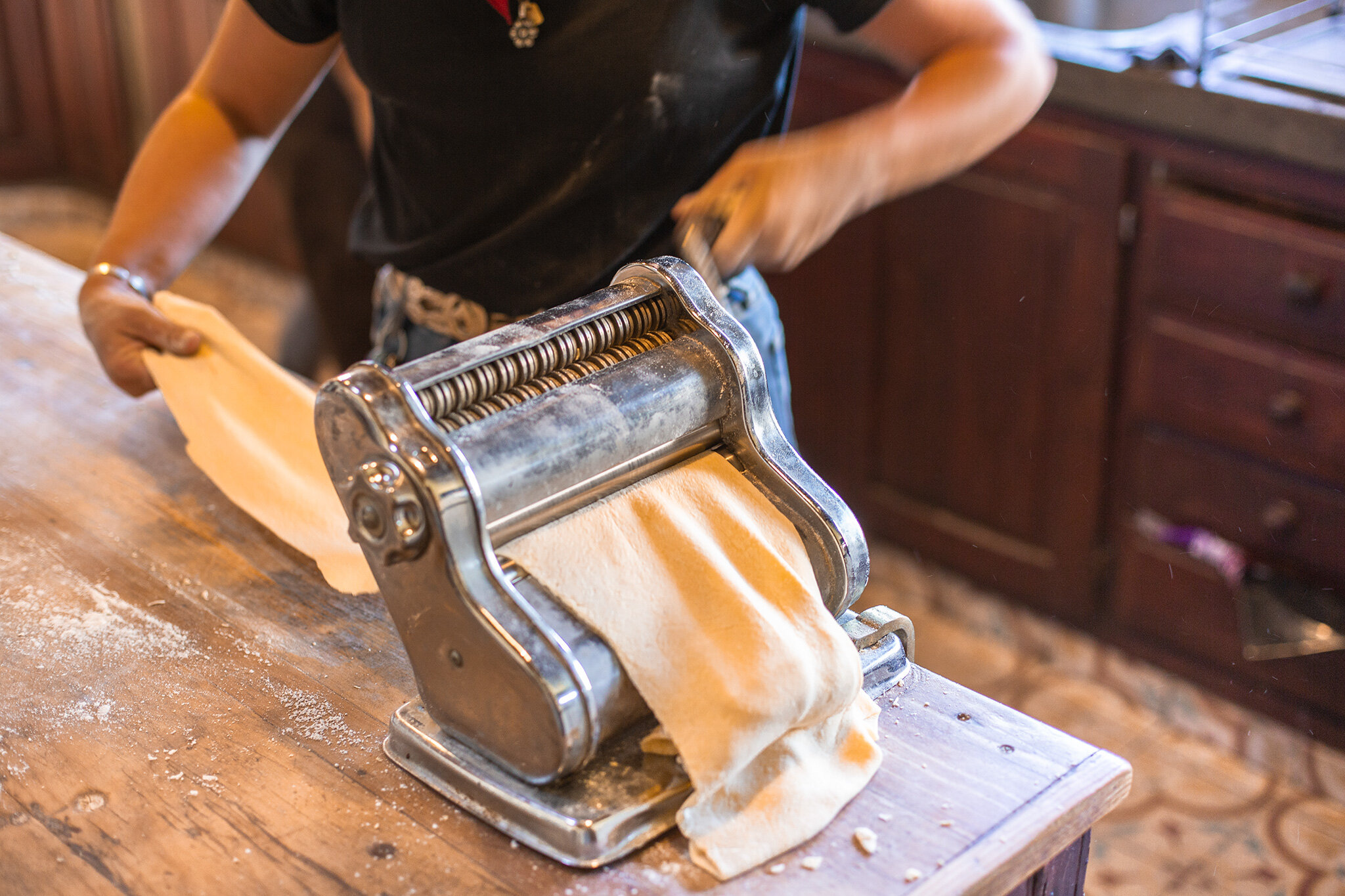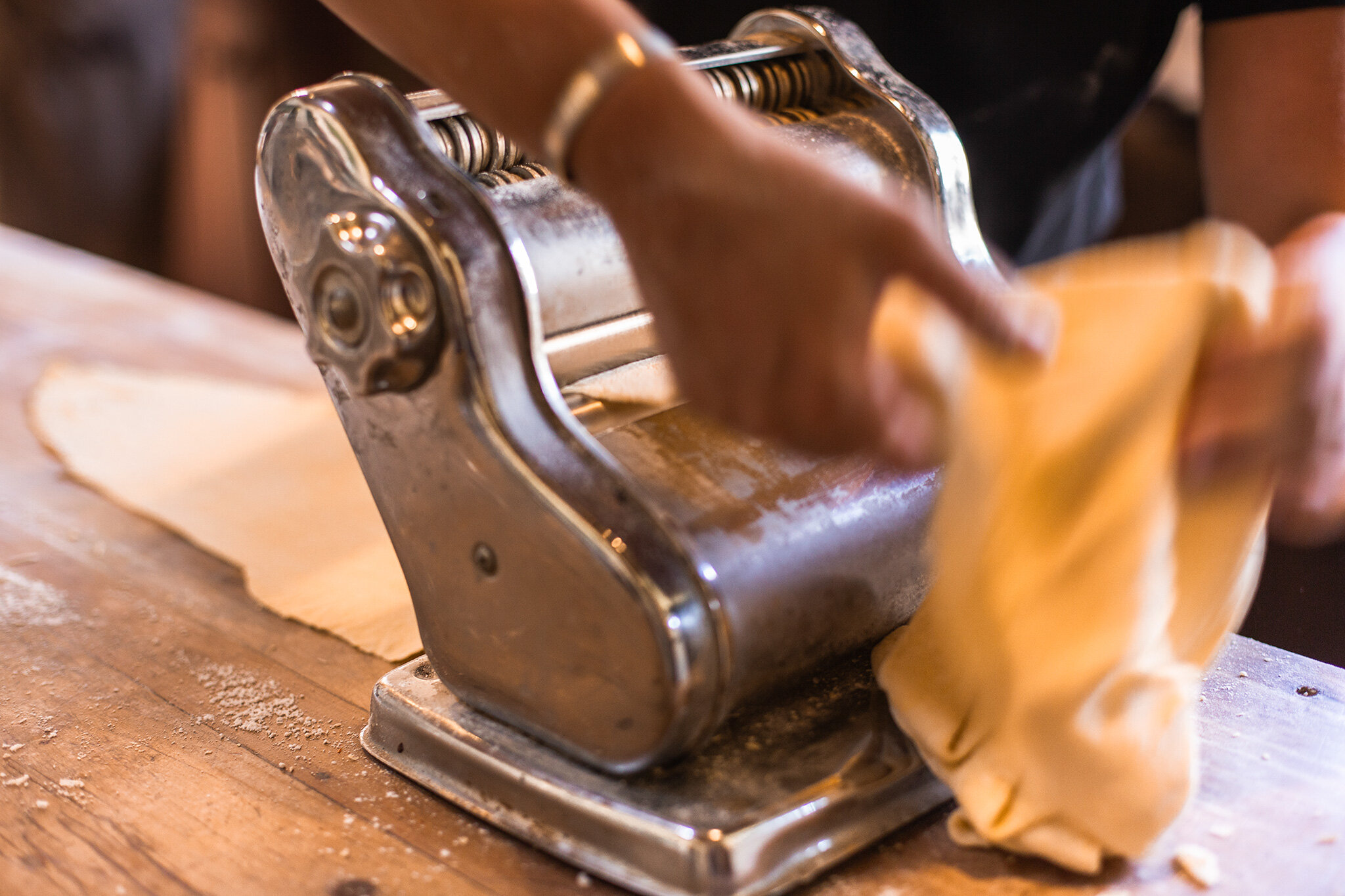Pizza a la Parrilla
This is a Los Potreros speciality, the smoky taste of the pizza base from cooking outside on the parrilla combined with four different cheeses from Argentina and a rich tomato sauce is a speciality and one of our most popular lunches. Alongside making it a meal, we often use it as a ‘picada’ before an asado.
Serves 6
375ml tomato passata
Fresh basil and oregano
150g cheddar cheese, grated
150g blue cheese, crumbled
150g mozzarella
150g additional hard cheese (we use an unaged Parmesan)
2tsp dried oregano
2tsp chilli flakes
2 garlic, chopped
2 onions, diced
2tsp dried yeast
1 tsp sugar
450ml warm water
600g 00 flour, plus extra for dusting
1/2 tsp salt
2tbs olive oil
Preheat the oven to 200ºC/390ºF or light your fire if you are cooking on a grill or outdoor pizza oven.
To make the dough combined the flour and salt in a bowl and make a well in the centre. Pour in the yeast mixture with olive oil, and the warm water and knead for around 10 minutes until the dough is sticky and smooth and no longer sticks to your hands. If the dough is to sticky add more flour or water if it becomes to dry.
Using floured hands, transfer the dough to a lightly oiled bowl and cover with a tea towel and leave to sit for an hour until it has doubled in size.
Whilst you are waiting for the dough to prove, make the sauce by sautéing the garlic, onions and then adding the tomato passata, herbs and allow to cook through. Grate the cheese and leave to sit out of the fridge, this will help them to cook a little faster.
Divide the dough into two portions, on a lightly floured surface, roll and stretch out the dough to form a large thin circular or rectangle shape Transfer onto a lightly floured baking tray and repeat with the second.
If you are cooking on an outside grill, ensure you have plenty of coals and rub some olive oil into the dough to. make sure it does not stick and cook on each side. If you are cooking in the oven place the baking tray in the hot oven and flip the dough over as it starts to colour. This will happen quite quickly if the oven is hot! Otherwise transfer the dough into the pizza oven and allow the dough to go golden on each side. Remove from the oven and spread the tomato passata over the base and sprinkle with cheese and any remaining herbs. Argentines often add parma ham, onion or fresh olives as toppings. Once you have topped according to taste cook again long enough for the cheese to melt.
April in the Kitchen
Lemon, Ginger & Mint Lemonade
3 Lemons or Limes, peeled
1/2 root of ginger
2 tsp honey
Sugar and Water - added to taste
In a food processor blitz the lemons and ginger with a splash of hot water and two teaspoons of honey until it makes a paste, add a splash more water.
Sieve into a jug over ice and top with water, add sugar according to taste.
Serve cold with sprigs of fresh mint.
January in the Los Pots Kitchen
Milanesas
Milanesas are simple but delicious, and found across Argentina - a thin slice of marinated beef, fried in hot oil and served with a variety of accompaniments. Every Argentine will tell you that the best milanesas are found at home cooked by their mothers! The dish is similar to an Austrian schnitzel but the roots of the milanesa stem’s back to Italy and more specifically Milan and the famous “Cotoletta alla Milanese”. The most simple version is served with a squeeze of lemon juice, and a side of creamy mashed potatoes or french fries, but it can often be served a caballo (on horseback) where a fried egg is served on top of the meat or a milanesa a la napolitana, which has a topping of tomato salsa, ham, and mozzarella cheese.
Serves 6
900g rump beef, thinly sliced (1 cm thick)
2 eggs, beaten
450g breadcrumbs
2 garlic cloves, diced
3 tbsp parsley, chopped
Vegetable oil (for frying)
Salt and Pepper
Slice the beef into cm thick steaks.
Cut off all the fat and trim the cutlets.
Tenderise the meat with a mallet until it is half a cm thick.
Whisk the eggs with chopped garlic, parsley, salt and pepper.
Marinade the meat in the egg mixture for at least half an hour, storing them in the fridge during the process.
Pour the oil into a deep frying pan and heat it up until a cube of bread dropped in starts to fry immediately.
Coat the beef in breadcrumbs and fry them on both sides and then place on a paper towel to remove excess oil.
* They are traditionally served with a mixture of the following; french fries, mash potato, green salad, coleslaw or in a bread roll with tomatoes, lettuce and mustard.
Quince Jelly and Dulce de Membrillo
Inside all bakeries in Argentina, there are glass display cases overflowing with coconut-rimmed tarts filled with glistening, red jam. These are all made using 'dulce de membrillo’, which is a quince paste. The Begg’s fondly remember their grandmother, making quince jelly and paste at Potrero de Niz when they were children. Tying a tea towel around the legs of a chair she would construct a sieve to drain the quince separating the paste from the jelly. Inedible raw quinces look like a cross between a pear and a golden apple, once cooked they turn sweet, with a vibrant red colour and have an incredible floral smell and taste.
Quince Jelly
1.5kg quince, chopped roughly
1 lemon, zest peeled into strips, juiced
900g sugar
Put the quince and lemon peel and juice in a large, deep saucepan. Cover with water (you'll need about 3 litres) and bring to the boil.
Reduce to a simmer and cook for 90 minutes until the quince is very soft.
Line a colander with muslin cloth and put over a very large saucepan or heatproof bowl. Tip the quince into the lined colander, cover with a clean tea towel and leave to strain for 4-8 hrs until all the juice has dripped out.
Keep the pulp for making ‘dulce de membrillo’. Measure out the strained juice and transfer to a large, deep saucepan (the jelly will bubble up high as it cooks). Add 500g sugar for every 600ml juice. Bring to the boil over a low heat, stirring to dissolve the sugar.
Bring to a rapid bubble and cook until the temperature reaches 105ºC/221ºF on a sugar thermometer. Remove from the heat and ladle into hot sterilized jars and seal.
Dulce de Membrillo
Making membrillo is extremely easy.
Take the quince pulp from the jelly and blend until smooth. Weigh the puree then put it in a large pot. Add an equal amount of granulated sugar to the mixture and place over a low heat. Stir the mixture constantly at first to dissolve the sugar, keep cooking until the mixture becomes thick (approx 1-2 hours). Once the mixture has thickened, it will stick to a wood spoon.
Line a baking dish or lightly grease before pouring in the quince mixture. Allow the paste to cool, before placing in the oven on the lowest heat, dry the paste out (this can take up to three hours, if it has not set keep it in the oven checking it regularly). The surface should be glossy and not sticky to touch. Put the dish in the fridge and refrigerate overnight.
Summer in the Kitchen - Part 2
As the summer stretches on we begin to harvest the figs - found across the estancia from our cattle station to the garden at Potrero de Niz. Whilst they are sweet they work perfectly with cheese, meat and other savoury foods. This year we have made lots of fig jams and chutney and with the final harvest we are going to try out hand a honey poached fig with orange and spices.
The quince is always the last fruit of the orchard to ripen, when they turn a golden yellow, and omit a floral scent, you know it is time to get picking. To preserve the quince we looked at lots of different ideas and followed the Mediterranean influence of cooking the quinces in a sweet syrup to be enjoyed on our homemade yoghurt or even on fresh cheeses like labneh (something Kevin has been learning to prepare).
Of course, there is nothing more Argentine and traditional than making quince jelly and membrillo, which go together hand in hand. First you make the quince jelly, boiling the fruit with sugar and allowing the colour to turn from yellow to a rich reddish pink. Following in the footsteps of Louie Begg, we separate the quince through a sieve constructed by a chair turned upside down and a tea-towel tied around the legs. This divides the quince jelly from the quince paste (the membrillo).
In the coming weeks the walnuts will be falling from the trees and the artichokes “topinambur” will be ready to be dug up and stored for the winter. Throughout the year there is always something to do and ways to save the fresh produce for the months ahead. We are looking forward to continuing this research into preserving foods and how we can learn to use nature to help us in reducing our overall carbon footprint.
Pan Dulce
One of our favourite sweet breads is ‘Pan Dulce’ and it is the perfect accompaniment to some Argentine cheese and is often cooked at our evenings in the kitchen. Typically we use dark muscovado sugar, which is a cane sugar containing molasses - the reason behind its dark colour and texture which resembles wet sand.
500g Self Raising Flour
1 Egg
25g Butter
Cup of Mate Cocido Tea
75g Dark Muscovado Sugar
150g of Dried Fruit
75g Almonds
75g Hazelnuts
Mix all the dry ingredients except the flour.
Add butter and egg, mix with hands throughly.
Add flour and tea accordingly to make the mixture into a dough, it is ready when it no longer sticks to your hands.
Once the dough is ready, form it and place on a baking tray which is sprinkled with a little flour to ensure it does not stick during the cooking process.
Cook in oven of 180ºC/355ºF until a skewer comes out clean.
This usually takes around 20 minutes.
Pasta
Across the country menus feature a variety of pasta dishes that the Italian immigrants of the late nineteenth and early twentieth century brought with them. The rolling of the pasta dough is a true art and it is always a delight to see our chefs effortlessly rolling out the dough to make anything from lasagne sheets to fresh raviolis or spaghetti.
Follow the link for our basic pasta dough recipe and why not try making out sorrentino’s.
Choripan
Here in Argentina, summer is almost upon us and one of our favourite lunchtime meals is Choripan. Arriving at our cattle station, Chiviquin, the smell of wood burning and the distinct sound of sausages grilling the gauchos are cooking lunch. Choripan is an Argentine street food staple, cooked on the 7 Fuegos or a hot grill plate and served in crusty french bread with a vast array of condiments.
Traditionally an Argentine chorizo which is more like an English or US sausage made of a combination of pork, beef and pork fat is sandwiched with crusty french bread, tomato and lettuce, then topped with a varied combination of condiments including chimichurri.
Everything Cookies
Mate
‘Mate’ is integral to the gaucho culture and learning how to drink it is an art. Pronounced mat-aay, mate is the name of the pot or gourd from which you drink it. The tea or herb is simply called ‘Yerba’. The drinking of mate is offered by the server, the ‘cebador’. The leaves are covered with hot water, not boiling, and the liquid is sipped through a ‘bombilla’, the metal straw. It is often passed around between friends and family, mate is a shared experience. One mate gourd is passed around the room for all share, whether you are family, friends or strangers. The yerba mate grows wild in the subtropical jungles of Argentina, Paraguay, Uruguay, Brazil and Bolivia. It is renowned for its energetic properties and is an old Guarani tradition from the native Indians in South America.
Mate is one of the drinks which falls into the category of needing an acquired taste. It is not uncommon to see Argentines walking down the street with a thermos of hot water under their arm and a mate gourd in their hand, as they drink, talk and walk. During the long process of Argentina’s independence in the 19th century, the tradition of mate gained strength across the country and the gauchos adopted mate as a part of their culture. Mate is particularly popular with Argentines especially in the morning as it contains a high amount of caffeine. Alongside a high caffeine content, it is also full of anti-oxidants and vitamins containing seven of nine essential amino acids.
Osobuco
One of our favourite and most celebrated meals on the estancia is Osobuco. There is nothing nicer than walking in for dinner to be greeted by the aroma of red wine and rosemary. The chefs prepare the osobuco at lunchtime and the meat braises for at least 5 hours throughout the afternoon, ensuring the meat is soft and full of flavour when they go to take it for dinner the beef falls spectacularly off the bone.
Gnocchi
In Argentina the 29th day of the month is the chosen day to eat gnocchi (Ñoqui in Spanish). The story of the tradition is pretty simple. The 29th of the month was just before payday — people got paid on the last day of the month — so by the end of the month, money was tight and all that was left in the larder was potatoes and flour. Gnocchi are the perfect solution as they are filling and not expensive. Eating gnocchi on the 29th is also considered to bring financial luck. To ensure a prosperous month ahead many Argentines will place money under the place mat whilst they eat. Like many traditions in Argentina this has come from Italian immigrants who came to work and live here in the 19th century.
Quantities for 6 people
5 big potatoes*
4 Egg
3 cups of flour
Wash potatoes and boil with skins on. Peel the potatoes and mash one at a time. Let the potatoes cool by pushing out onto a surface, the larger the surface area the quicker they will cool. Once you have the potatoes cooled and flat on the counter crack one egg into the middle and mix well. Mix in flour, folding and pressing the mixture out to ensure the flour and potatoes are combined. Always add more flour until they become firm but still malleable. Cut the mixture into equal parts and roll into a sausage and cut into small pieces about 2cm x 1cm. Prepare the sauce. Cook the gnocchi in hot water, when they rise to the surface they are cooked. Have a dish ready to put in the oven to keep the gnocchi warm whilst you cook the rest. Layer the sauce first in the pan followed by the cooked gnocchi. Place it in the oven and once you have the next batch ready place more sauce over the first batch and then add the next round of gnocchi.
* The fresher the potatoes are the better the gnocchi - use one potato per person and then three more.
Chicken Asado
The asado originated in the 19th century with the gauchos, the word is used to describe both the occasion and the meat itself, traditionally wood from the White Quebracho tree would be used as it is relatively smokeless and produces good coals. Whilst beef is the focus of the asado many argentines also choose to cook chicken. Lunches at Los Potreros include both options but we particularly love a chicken asado. Chicken cooked on the parrilla marinated with lemon, onion, garlic, fresh herbs and olive oil. The preferred method is cooking the chicken as a whole butterflied.
1 Chicken
3 Onions
4 Garlic Cloves
Lemon Juice
Fresh thyme & rosemary
Olive oil
To prepare the parrilla for cooking you will need a lot of coals and a higher temperature than cooking beef, so ensure you light the fire around 30 minutes earlier than if you were cooking a normal asado. Light the fire around 11am to have sufficient time to begin cooking for a 1330 lunch. You will need minimum of one and a half hours to cook the chicken and must always put chicken on the parrilla for half an hour more than any red meat. Using a butterflied chicken place on the parrilla bone face-down and allow the chicken to start cooking. To check if the grill is hot enough hold your hand above it and if you can hold it for longer than 10 seconds you need to add more coals. Peel the onions and garlic and blend with the lemon juice and olive oil until it produces a thick paste and roughly cut the fresh herbs and add them to the mix. Brush the chicken with the paste whilst cooking, 3 or 4 times until serving, to ensure the chicken stays moist and does not become too dry. Turn the chickens regularly so they don’t burn and to allow for even cooking.
* goes really well with a fresh salad and bread cooked on the parrilla. Top the bread with fresh tomatoes diced with oregano, diced onions and a little olive oil.
Our Sustainable Kitchen
Every chef across the world, pays close attention to what goes into their food but here at Los Potreros we are also concerned about what our food is doing to the environment. Our chefs have always had a “no waste mentality” and now more than every they are minimizing what they throw out and developing a menu to ensure they can continue to cut down what little waste we still have, throughout the last few months we have begun to test out new ideas with great success.
Pollo Al Disco
Food prepared “al disco” does not refer to a particular recipe but rather a cooking style.
Traditionally farm workers would use the blade of their plough; flipped on its side, wiped clean and with a fire lit below - these days we use a huge iron plow disc heated over a wood fire, but you can recreate this in a heavy bottom pan. Discos provide a large surface area for cooking while remaining easily portable, they are particularly useful for preparing meals away from the kitchen.
The following recipe for pollo al disco is using white wine, but this can be substituted with beer.
Serves 4
3 x chicken breasts - either cooked whole or cut into chunks
2 onions
2 red peppers sliced
2 green peppers
A handful of fresh herbs chopped
2 diced garlic cloves
Cream
Chilli flakes
Paprika
2 bay leaf
White wine
Water
Olive oil
To prepare the chicken use breast meat or cut into chunks on the bone (if leaving pieces on the bone it will take longer to cook). Once the disco is placed over the flames begin cooking immediately or it will burn and smoke. Add a splash of oil and sauté the chicken, stirring often until the chicken has colour all over. Once the chicken has begun cooking add the onions and garlic, allow to soften. Then add white wine, peppers, spices and herbs - flavor according to taste. Continue to add wine and water throughout cooking to ensure the meat doesn’t dry out. Stir often. Do not taste the sauce until the chicken is cooked.
Once the chicken has been cooked, and you are ready to serve drizzle some cream over the chicken, as you plate it.
Salsa Criolla
The argentine version is called Salsa Criolla, made with chopped peppers, onion, tomato, garlic and tossed with white wine vinegar and olive oil. Salsa Criolla is the perfect complement to beef, alongside chimichurri. It is also a popular topping for most Argentine street food like “choripan”. Although it is meant to be served fresh it can be kept for a few days in the fridge.
Chimichurri
Chimichurri is traditionally made of finely-chopped parsley, garlic, oregano, oil and white vinegar. Though there are regional variations, it is also a recipe which is usually kept as a closely guarded secret. Chimichurri is not a marinade as argentines tend to use salt as the only seasoning on a piece of beef but it is used as a condiment at any asado.












